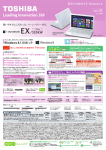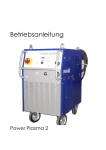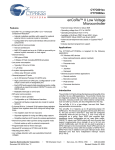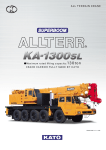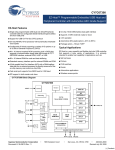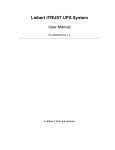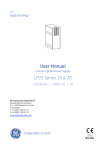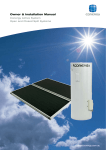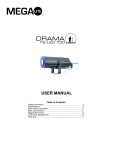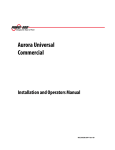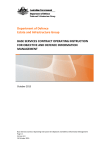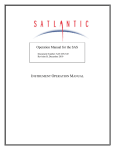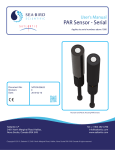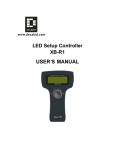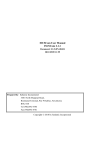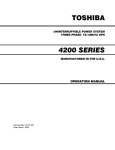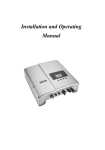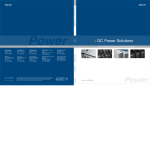Download ZBB 200kW PCS
Transcript
Letsk 100kW / 100kVA BATTERY/ PV POWER CONDITIONING SYSTEM ‘PCS’ INSTALLATION & OPERATION USER MANUAL IMPORTANT SAFETY INSTRUCTIONS SAVE THESE INSTRUCTIONS – This manual contains important instructions for hybrid Power Conditioning System (PCS) that shall be followed during installation and maintenance of the inverter for Battery applications. Please read all instructions before operating the equipment and save this manual for future reference. MANUAL NO. : PM00419 REVISION NO. : 3 DATE : Jan, 2010 SATCON POWER SYSTEMS CANADA LTD. 835 HARRINGTON COURT, BURLINGTON, ONTARIO CANADA L7N 3P3 TELEPHONE: (905) 639-4692 FAX: (905) 639-0961 © 2007-2010 Satcon. This document is the confidential and proprietary information of Satcon. No part of this document may be photocopied, reproduced, stored in a retrieval system, or transmitted in any form or by any means whether electronic, mechanical, or otherwise without prior written permission. Satcon reserves the right to change details in this publication without notice. PowerGate® Plus and PV View® Plus are the registered trademarks of Satcon. Edge is a trademark of Satcon. Other product names and/or organization names mentioned may be trademarks and/or registered trademarks of their respective companies. Publication Number Date and Revision REV. 0 1 2 3 ECO 9641 9641 9641 9641 DATE Jan 29, 2010 Jan 29, 2010 Jan 29, 2010 Jan 29, 2010 AUTHOR HK HK HK HK APPR. KS KS KS KS COMMENT Table of Contents CHAPTER 1 .............................................................................................................................................................1 - 1 1.0 INTRODUCTION .........................................................................................................1 - 1 1.1 DESIGN FEATURES ....................................................................................................1 - 2 1.2 DESIGN CONSIDERATIONS .....................................................................................1 - 3 1.3 SYSTEM OUTLINE .....................................................................................................1 - 5 1.3.1 DC disconnect switches for PV and Battery inputs ...........................................1 - 5 1.3.2 DC load break contactors for PV and Battery inputs ........................................1 - 5 1.3.3 Battery and PV current and voltage sensing .....................................................1 - 5 1.3.4 DC fuses for chopper inputs and PV input ........................................................1 - 6 1.3.5 DC reactors........................................................................................................1 - 6 1.3.6 Buck-Boost choppers ........................................................................................1 - 6 1.3.7 DC link capacitors .............................................................................................1 - 7 1.3.8 Three phase inverter module .............................................................................1 - 7 1.3.9 Output AC filter reactor and AC filter capacitor ...............................................1 - 7 1.3.10 Output AC contactors ........................................................................................1 - 7 1.3.11 Isolation transformer .........................................................................................1 - 8 1.3.12 Output breakers for load and generator for short circuit protection...................1 - 8 1.3.13 Pre-charge circuitry to limit current inrush to specified levels ..........................1 - 8 1.3.14 Surge suppressors ..............................................................................................1 - 8 1.3.15 Logic Control and Protection 1-9 CHAPTER 2 .............................................................................................................................................................2 - 1 2.0 IMPORTANT SAFETY INSTRUCTIONS...................................................................2 - 1 2.1 GENERAL ........................................................................................................................................................... 2 - 1 2.2 2.3 2.1.1 Precautions ........................................................................................................2 - 1 2.1.2 Electrical Safety ................................................................................................2 - 2 2.1.2.1 General ..............................................................................................2 - 2 2.1.2.2 Shock Prevention ..............................................................................2 - 2 2.1.2.3 Service and Maintenance ..................................................................2 - 3 2.1.2.4 Fire and Explosion Prevention ..........................................................2 - 3 2.1.2.5 Bodily Injury Prevention ...................................................................2 - 3 2.1.2.6 Medical and First Aid Treatment ......................................................2 - 3 2.1.2.7 Equipment Precautionary/Warning Labels ........................................2 - 3 ELECTRICAL SAFETY FEATURES ..........................................................................2 - 4 2.2.1 Enclosure Door Interlock Switches ...................................................................2 - 4 2.2.2 E-Stop Button ....................................................................................................2 - 4 HANDLING & INSTALLATION SAFETY.................................................................2 - 4 2.3.1 General ...........................................................................................................2 - 5 2.3.2 Over-current Protection (AC & DC Circuit) .....................................................2 - 5 2.3.3 Wire Sizes for cust. interface, Torque Specifications & Special Symbols ........2 - 6 CHAPTER 3 .............................................................................................................................................................3 - 1 3.0 INSTALLATION & OPERATING INSTRUCTIONS .................................................3 - 1 3.1 INSTALLATION ................................................................................................................................................ 3 - 1 3.1.1 Assembly and Mounting ...................................................................................................................... 3 - 1 3.1.2 Grounding Means ................................................................................................................................ 3 - 2 3.1.3 Ventilation Considerations .................................................................................................................. 3 - 2 3.2 EQUIPMENT MARKINGS / RATINGS ........................................................................................................... 3 - 3 3.3 INPUT / OUTPUT INTERCONNECTIONS ..................................................................................................... 3 - 6 3.4 OPERATING INSTRUCTIONS ....................................................................................................................... 3 - 10 3.4.1 General .........................................................................................................3 - 10 3.4.2 PCS States ......................................................................................................3 - 11 3.4.3 PCS Control ...................................................................................................3 - 11 3.4.4 3.4.5 3.4.3.1 Sequence of events when Starting the PCS .....................................3 - 11 3.4.3.2 Sequence of events when Stopping the PCS ...................................3 - 13 3.4.3.3 Sequence of events during Fault Shutdown of the PCS ..................3 - 13 3.4.3.4 Sequence of events during E-Stop of the PCS.................................3 - 13 3.4.3.5 Low Battery Current........................................................................3 - 13 3.4.3.6 Battery Protection ............................................................................3 - 14 Local Operating Procedures ............................................................................3 - 14 3.4.4.1 Local Control Panel & System Diagnostic LED Description ..........3 - 14 3.4.4.2 OIT Description ..............................................................................3 - 15 Remote Operating Procedures .........................................................................3 - 36 3.4.5.1 Data Flow Arrangement Between PLC and PCS-DPCB.................3 - 36 3.4.5.2 Protection for Losing Remote Communication ...............................3 - 44 3.5 TRIP POINTS .........................................................................................................3 - 45 3.6 PREVENTATIVE MAINTENANCE..........................................................................3 - 49 3.6.1 Power Components..........................................................................................3 - 49 3.6.2 Control Components - Electronic ....................................................................3 - 50 3.6.3 Fans / Blower & Air Filter Maintenance .........................................................3 - 50 3.6.4 Workmanship ..................................................................................................3 - 51 CHAPTER 4 .............................................................................................................................................................4 - 1 4.0 APPLICABLE DOCUMENTS AND DRAWINGS ........................................................................................... 4 - 1 1 1.0 CHAPTER 1 INTRODUCTION Satcon Technology Corporation has experience in numerous inverter applications for grid connected and independent three phase loads as well as a number of distributed resource application inverters (alternative energy). The 100kVA PCS for battery/PV application is designed to interface with the dc power from the battery and Photovoltaic Array output and supply the power to the load. The PCS at the same time has a Generator as a backup power in case the battery and PV power were under the power required by the load. The power conditioning system is designed for three-phase output connection of 480Vac at 60 Hz operation with an output transformer for North American application. The solid-state technology used in the design is of proven reliability and is based upon a number of commercial products. A number of circuit implementation techniques used are novel in nature and lead to basic design features common to the PWM series of inverters. The basic design philosophy emphasises the isolation of single component failures, such that multiple component failures do not occur. This leads to a low MTTR, (Mean Time To Repair), due to extensive fault diagnostic circuits and easy accessibility of major components. Design engineering and manufacturing of all inverter systems, under a strictly implemented Quality Assurance Program, has led to similarly designed equipment being delivered with long MTBF, (Mean Time Between Failure). Chapter 2 provides the important installation safety instructions that must be followed while installing the power conditioning system. Chapter 3 describes the installation, handling, grounding means, ventilation considerations, equipment markings, input / output interconnections, operating instructions, field adjustable trip point procedures and preventative maintenance. Chapter 4 includes the list of drawings for the power conditioning system user. 1.1 DESIGN FEATURES SPS JOB NO. 95093 INSTALLATION AND OPERATION MANUAL The information of this document is proprietary and not to be reproduced without permission 1-1 The basic design features of the 100kVA power conditioning system for battery application are as follows: 1. The unit is designed according to the customer’s specification of 100kVA power conditioning system. 2. The unit has three modes of operation, namely: “inverter mode” in which power is exported to the load from the batteries and photovoltaic cells, “Generator mode” where the power is used from the generator to supply the load and also charge the batteries and “Parallel mode” which happens for a short period of time while the PCS is transferring the load from inverter to generator or ViseVersa. 3. The control for “inverter mode” is AC Voltage control, for “generator mode” depending on the stage of charging switches from Current control to voltage control on the chopper and for “parallel mode” is AC Current control. 4. The three phase output voltages and currents are sinusoidal with low total harmonic distortion meeting the Harmonic specification required per Q06-0619. 5. The inverter and chopper use 1200V rated IGBT’s for fast switching, high switching frequency and high efficiency. The state of the art inverter and chopper stack with sandwiched bus bar design are used, increasing the efficiency and reliability of the system. 6. The control circuit uses Digital Power Control Board (DPCB) using DSP (Digital Signal Processor) and FPGA (Field Programmable Gate Array) for control, system monitoring and protection. 7. All areas sensitive to over-temperature conditions are monitored with thermal detectors. Extensive electronic fault detection schemes, with fuses are employed to ensure safety of critical circuits. SPS JOB NO. 95093 INSTALLATION AND OPERATION MANUAL The information of this document is proprietary and not to be reproduced without permission 1-2 8. Use of DSP based control allows for advanced control strategies such as field-oriented control, D/Q Frame control, and predictive control resulting in improved system dynamic response, stability and accuracy. Use of two DSP with a dual port SRAM architecture provides parallel processing capability. 9. Most of the components selected in the power conditioning system are CE, CSA or UL listed or recognized to equivalent approval agency. 1.2 DESIGN CONSIDERATIONS The power conditioning system for the 100kVA Battery/PV System is designed using customer’s specifications, international standards such as IEEE, CSA, UL, IEC etc. and sound engineering practices to develop a rugged product capable of providing years of service. The components used in the Power conditioning system are UL or CSA or CE listed or recognized where applicable. The general design features of Satcon products include the following: Enclosures: Rugged heavy gauge metal with enamel coated paint on all surfaces, NEMA standards are followed to ensure a good design. All removable internal panels are 11 gauge galvanized. All surfaces are painted 2 coats of rust inhibiting primer and painted. The enclosure meets the NEMA 3R rating. Assembly: All components are secured by mechanical means independent of electrical connections. The robust design ensures that the unit can withstand all transportation shock and vibration. Layout of the electrical panels minimizes overlaying of the components and replacement components are easily accessible to the service personnel. Special care is taken in the design so that Mean time to Repair is kept minimum. All the adhesives, silicone sealant, acoustic foam, glastic insulators, wire way bushings etc used in the power conditioning system are chosen from UL listed or recognized component list. Wiring: Wiring used in the PCS is a high temperature TEW (90C) or Tefzel (105C) wires, which has a minimum insulation level of 300Volts for control circuits and 600V, or 1000V for the power circuit as applicable. Bundled conductor ampacity is reduced according to CSA and National Electrical Code de-rating factors. Minimum of 12 gauge wiring for the power conductors is used in the PCS system. UL1741 standard guidelines are followed in terms of wire routing, spacing and bending radius etc. SPS JOB NO. 95093 INSTALLATION AND OPERATION MANUAL The information of this document is proprietary and not to be reproduced without permission 1-3 Magnetics: Transformers and reactors are designed at the rated load and for continuous duty plus the specified overload. Higher ambient temperatures are also taken in to account while spec’ing out the magnetic. Flux densities are maintained with margin for specified over-voltages. The temperature class of insulation is Class 220 (Class R) independent of designed temperature rise. The magnetics are vacuum pressure impregnated (VPI) with polyester resin for durability and protection against the environment. The transformer and reactors are forced air cooled by ambient air and designed with a 1.10 service factor for long life. All the magnetic used in this power conditioning system are CSA and UL listed or recognized. Capacitors: Capacitors are applied at values well below their continuous design rating. The capacitor chosen in this application is medium power film capacitor which uses a dry-wound (non-oil-filled) segmented metallized polypropylene or polyester dielectric, which features the controlled self-heating process, specially treated to have a very high dielectric strength in operating conditions up to 85 degree C. These capacitors can with stand much higher levels of surge voltage, very high rms currents and longer lifetime than their electrolytic counterparts. Resistors: Satcon standard resistor margins are normally twice the power rating of the application, hence very reliable. Breakers & Contactors: The circuit breakers and contactors are applied at values well below their continuous design rating, generally around 75% of the rating. Higher ambient temperature and frequency de-rating factors are applied on the circuit breakers and contactors to ensure a reliable design and long lasting product. The circuit breakers are rated for interrupt rating as specified in the customer specifications. IGBTS: The isolated gate bipolar transistors (IGBTs) are selected to operate well within the Safe Operating Area (SOA) of the device specification for 100% load and any specified overloads. Laminated bus bars are used in the inverter and chopper assemblies to reduce the inductance on the dc side and hence the switching losses and overshoot on the devices. These state of the art power electronic assemblies use minimal snubber circuits which results in fewer parts count, hence increasing the reliability of the PCS and efficiency. Printed Circuit Boards: All the printed circuit boards used in the PCS system are conformally coated (optional, not supplied with this system) for longevity and adverse weather & site conditions. All printed circuit boards are manufactured as per IPC-A-610 class 3 standards. SPS JOB NO. 95093 INSTALLATION AND OPERATION MANUAL The information of this document is proprietary and not to be reproduced without permission 1-4 1.3 SYSTEM OUTLINE The one line diagram used to illustrate the circuit topology of the unit is shown in Drawing # SD00142. The 100kVA power-conditioning unit consists of the following major components: 1.3.1 DC disconnect switches for PV and Battery inputs 1.3.2 DC load break contactors for PV and Battery inputs 1.3.3 Battery and PV Current & Voltage Sensing 1.3.4 DC Fuses for Chopper inputs and PV input 1.3.5 DC Reactors 1.3.6 Buck-Boost Choppers 1.3.7 DC Link Capacitor 1.3.8 Three Phase Inverter Module 1.3.9 Output AC Filter Reactor & AC Filter Capacitor 1.3.10 Output AC Contactors 1.3.11 Isolation Transformer 1.3.12 Output breakers for load and generator for short circuit protection 1.3.13 Pre-charge circuitry to limit current inrush to specified levels 1.3.14 Logic Control and Protection The following sections describe these major components of the power circuit in detail. 1.3.1 DC DISCONNECT SWITCHES FOR PV AND BATTERY INPUTS (DS1 AND DS2) DC disconnect switches are used to isolate the PV and Battery inputs from the inverter for maintenance purposes. These switches are equipped with auxiliary NO and NC contacts for control system monitoring. It is not recommended to open the disconnect switches under load condition. In emergency situations operate Emergency stop Button or Start/Stop switch to stop PCS before opening the disconnect switches. 1.3.2 DC LOAD BREAK CONTACTORS FOR PV AND BATTERY INPUTS DC Contactors are used to isolate the battery and PV inputs to the PCS during the off and overload condition. Two single pole contactors are used to isolate battery and PV circuits (one each). CR1A is used in PV circuit and CR1B is used in Battery circuit. 1.3.3 Battery and PV Current & Voltage Sensing (LEM1, LEMDC1-3 & RDC1-2 AND DCVS) LEM1, a DC current sensor is used to measure the dc current from the solar array, LEMDC1-3 are used to measure the three currents flowing in between the choppers and the battery bank. The current sensors chosen are highly immune to external interference and have wide frequency bandwidth. SPS JOB NO. 95093 INSTALLATION AND OPERATION MANUAL The information of this document is proprietary and not to be reproduced without permission 1-5 These current sensors provide the current information for controls to the digital board. The sensing board DCVS, is an accurate voltage sensor used to measure Battery voltage. Voltage divider networks RDC1 and RDC2 provide voltage information from PV and DC Link to the digital board for control purposes. 1.3.4 DC Fuses (FUDC1-4) The DC fuses FUDC1-3 are provided for backup protection and current limiting. There are 3 buck-boost choppers in total and each Chopper’s +DC branch is fused. The choppers are fused only in the positive leg, since the batteries are grounded at the negative terminal. FUDC4 provides over current protection for the PV input to the PCS. These DC fuses are equipped with fuse indicators and this information is fed back to the control logic for monitoring. 1.3.5 DC Reactors (LF1-3) The DC input reactor is used for energy storage in the buck-boost chopper and to limit the rms ripple current to less than 2% of the current. It is a high efficiency design optimized for the switching frequency of the chopper. A DC reactor is used per buck-boost chopper, hence total of 3 dc reactors in the PCS. The switching is 120 degree shifted on each chopper to reduce the ripple. The reactor is dry type wound with class 220 insulation. The unit is vacuum pressure impregnated (VPI) with polyester resin for durability and protection against the environment. The reactors are forced air cooled by ambient air and designed with a 1.10 service factor for long life. The reactors include over-temperature switches for protection and indication on the panel display of the PCS. 1.3.7 Buck-Boost Choppers The buck-boost choppers (x 3) are comprised of IGBT modules for boosting the voltage from the battery to the DC voltage required by the inverter or decreasing the voltage while charging the batteries off the DC link voltage. The power-flow is bi-directional i.e. the batteries can be discharged or charged via these choppers. The amount of boost is controlled by pulse width modulating (PWM) of the IGBT as signalled by the DPCB control logic. There are three buck-boost choppers in the PCS. The pulse width modulation is done at a frequency (2.5kHz) that minimises switching losses and to provide the required performance. The IGBT’s are mounted on air-cooled heat sinks. The modules use laminated bus bar construction for interconnection to further reduce switching losses, and provide a high degree of power circuit integrity and reliability. The module is designed for easy replacement by bolted electrical connections to the laminated bus and connectors for gating and controls. The chopper module gate driver boards (DFOD) utilises fibre optic gating and protection circuitry for overcurrent & gating fault protection and indication on the panel display of the PCS. SPS JOB NO. 95093 INSTALLATION AND OPERATION MANUAL The information of this document is proprietary and not to be reproduced without permission 1-6 1.3.7 DC Link Capacitor (CF) The DC link capacitor is divided into three banks. The first capacitor bank is on the inverter assembly comprised of Film capacitors; the second capacitor bank is on the chopper assembly also comprised of film capacitors, which use dry-wound (non-oil-filled) segmented metallized polypropylene or polyester dielectric. The third capacitor bank, consists of electrolytic capacitors and is connected between the buck-boost choppers and inverter to supply transient energy to the inverter. 1.3.8 Three Phase Inverter Module The inverter is utilising IGBT’s with a high degree of voltage margin. The inverter converts the DC voltage from the DC bus to the desired AC output voltage. The AC output voltage is controlled by pulse width modulation (PWM) of the IGBT’s as signalled by the DPCB. The pulse width modulation is done at a frequency (5.0kHz) that minimises switching losses and to provide the required performance. The module IGBT’s are mounted on air-cooled heat sinks and uses laminated bus bar construction for interconnection to further reduce switching losses, and provide a high degree of power circuit integrity and reliability. Like the chopper module, the inverter modules are designed for easy replacement by bolted electrical connections to the laminated bus and connectors for gating and controls. The inverter module gate driver boards (DFOD) utilises fibre optic gating and includes protection circuitry for over-current & gating fault protection and indication on the panel display of the PCS. The inverter has AC Fuses (FUAC1-2-3) 700Vac at the output for over-current protection. These AC fuses are equipped with fuse indicators and this information is fed back to the control logic. 1.3.9 Output AC Filter Reactor (LO) & AC Filter Capacitor (CO) The output 3-phase AC filter reactor LO filters the inverter’s output voltage to eliminate any switching transients and is required for inverter energy storage. It is a high efficiency design optimized for the switching frequency of the inverter. The AC Choke is iron-core. The output filter capacitor CO is connected in delta and is on the primary side of the transformer and the capacitor selected is heavy-duty capacitor rated at 1000Volts AC. This L-C filter reduces the output current harmonics below 3% under steady state conditions. 1.3.11 Output AC Contactors (CR2A & CR2B) The 3-pole AC output contactors are used to isolate the power supply from the generator and load in a stop state and during the Power Conditioning System pre-charge starting period. The output contactors are equipped with DC coils for control and 1NO/1NC auxiliary contacts for monitoring. SPS JOB NO. 95093 INSTALLATION AND OPERATION MANUAL The information of this document is proprietary and not to be reproduced without permission 1-7 1.3.11 Isolation Transformer (TRO) The output isolation transformer is required for grounded battery applications and is used for voltage matching to 480 VAC line voltage application. The output transformer has Delta/Wye configuration and is rated at 115KVA & 170:480V ratio. This PCS can provide 480V at 60Hz. The transformer chosen is high efficiency design. The isolation transformer is a dry type transformer wound with class 220 insulation. The unit is vacuum pressure impregnated (VPI) with polyester resin for durability and protection against the environment. The transformer is forced air cooled by ambient air and designed with a 1.10 service factor for long life. The unit includes over-temperature switches for protection and indication on the panel display of the PCS. 1.3.12 Output Breakers for short circuit protection The AC breakers are used mechanical isolation and over-current protection. The interconnection breakers are equipped with auxiliary contacts position indicators for control monitoring. The current rating and trip setting of the breakers are as follows: CB1 1.3.13 Power (kVA) Nom. current (A) 100 121 CB2 OverBreaker current rating (A) limit (A) 250 152 Trip set. Nom. current (A) 0.7 121 Breaker rating (A) Overcurrent limit (A) Trip set. 250 152 0.7 Pre-charge Circuitry to limit current inrush to specified levels The pre-charge circuitry is used to limit the inrush current to a specified level during a start and to charge the dc bus to the required level. This circuit consists of a charging module CRCH and charging resistors RCH1-4. This circuit is also protected by dc charging fuse FCH1. 1.3.14 Surge Suppressor (SS1-2) Two surge suppressor modules are used at the output of the power conditioning system before the output AC interconnection breaker CB1 and CB2. These surge suppressors have formidable surge handling capability, and fast clamp response. SPS JOB NO. 95093 INSTALLATION AND OPERATION MANUAL The information of this document is proprietary and not to be reproduced without permission 1-8 1.3.15 Logic Control and Protection The logic control and protection consists of the following printed circuit boards and modules. All the printed circuit boards are conformal coated (optional, not provided with this system) for reliability and outdoor environment. 1) Voltage / Current Scaling Board – VCSB-4VI The main function of this board is to receive the input voltage and current signals from the sensors and scale down to the required level to be used by the digital power control board (DPCB). 2) Digital Power Control Board – DPCB The DPCB uses the DSP and FPGA (Field Programmable Gate Array) to generate PWM gating signals for the chopper and inverter, control and regulation, start / stop sequence, diagnostics and protection. System diagnostics and status are displayed on the front Operator Interface Terminal (OIT). Programmable software used for overall system control allows for system flexibility without the need for hardware change. This provides our customers with rapid response to their changing needs. 3) Gate Driver Board – DFOD These boards are the gate drivers for the IGBTs of chopper and inverter modules. In addition to the drive and isolation of the chopper/Inverter gating signals, they also provide shoot through fault protection and detection. The gate driver boards are connected to the Digital Power Control Board (DPCB) through fibre optic links. 4) LEM and Current Transformers LEMs1 and LEMDCs 1-3 are used to sense the DC currents of the PV input and buck-boost choppers respectively and LEMs A,B,C are used to sense inverter currents for control and protection purposes. Current transformers CT1A, CT1B & CT1C are used to monitor line current and CT2A, CT2B & CT2C are used to monitor generator current for control and protection purposes. 5) Voltage Sensing Transformers TRLS1-3, voltage-sensing transformers are used to sense the 3-phase output AC voltage for the control and protection logic. Voltage sensing transformers TRGS1-3 are used to sense the generator voltage for the control and protection logic. SPS JOB NO. 95093 INSTALLATION AND OPERATION MANUAL The information of this document is proprietary and not to be reproduced without permission 1-9 2 2.0 CHAPTER 2 IMPORTANT SAFETY INSTRUCTIONS This chapter lists all the safety instructions that need to be followed while installing and operating the Power Conditioning System. The following is merely a guide for proper installation. Satcon Technology Corporation cannot assume responsibility for the compliance or noncompliance to any code, national, local or otherwise for the proper installation of this Power Conditioning System or associated equipment. A hazard of personal injury and/or equipment damage exists if electrical codes are ignored during installation. 2.1 GENERAL 2.1.1 Precautions DANGER: This PCS contains LETHAL VOLTAGES. Authorized service personnel only should perform all repairs and service. There are no user serviceable parts inside the PCS. WARNING: Only qualified personnel familiar with the PCS design should plan or implement the installation, start-up and subsequent maintenance of the system. Failure to comply may result with personal injury and or equipment damage. WARNING: An incorrectly installed PCS may result in equipment damage or a reduction in product life. Incorrect wire sizing, inadequate supply, or excessive ambient temperatures may result in system malfunction. CAUTION: This PCS contains ESD (Electrostatic Discharge) sensitive parts and assemblies. Static control precautions are required when installing, testing, servicing or repairing this unit. Board component damage may result if proper ESD measures are not followed. SPS JOB NO. 95093 INSTALLATION AND OPERATION MANUAL The information of this document is proprietary and not to be reproduced without permission 2-1 WARNING: To avoid an electric shock, verify that the voltage on the bus capacitors has discharged before performing any work on the PCS. Measure the voltage across CF in PCS, it must be zero to be fully discharged. WARNING: The enclosure contains exposed high voltage conductors. The enclosure door should remain locked, except during maintenance or testing by trained service personnel. Do not open the cabinet doors if extreme moisture is present (rain, snow or heavy dew). 2.1.2 Electrical Safety WARNING – ELECTRIC SHOCK can KILL. Do not touch live electrical parts. ELECTRIC ARC FLASH can injure eyes, burn skin, cause equipment damage and ignite combustible material. DO NOT use power cables to break load and prevent tools from causing short circuits. 2.1.2.1 General Equipment that supplies electrical power can cause serious injury or death, or damage to other equipment or property. The operator must strictly observe all safety rules and take precautionary actions. Safe practices have been developed from past experience in the use of power source equipment. 2.1.2.2 Shock Prevention Bare conductors, terminals in the output circuit or ungrounded, electrically live equipment can fatally shock a person. Have a certified electrician verify that the equipment is adequately grounded and learn what terminals are electrically HOT. Use proper safety clothing, procedures and test equipment. The electrical resistance of the body is decreased when wet, permitting dangerous currents to flow through it. When inspecting or servicing equipment, do not work in damp areas. Stand on a dry rubber mat or dry wood, and use insulating gloves when dampness or sweat cannot be avoided and never work alone. The equipment must be installed and maintained with the National Electrical Code ANSI/NFPA 70, or other applicable codes. Inspect cables frequently for damage to the insulation and the connectors. Replace or repair cracked or worn cables immediately. Do not overload cables. Do not touch output terminal while equipment is energized. SPS JOB NO. 95093 INSTALLATION AND OPERATION MANUAL The information of this document is proprietary and not to be reproduced without permission 2-2 2.1.2.3 Service and Maintenance This equipment must be maintained in good electrical condition to avoid hazards stemming from disrepair. Report any equipment defect or safety hazard to the supervisor and discontinue use of the equipment until its safety has been assured. Qualified personnel should make repairs only. Make sure all the power is off and capacitors de-energized before doing any repairs. 2.1.2.4 Fire and Explosion Prevention Fire and explosion are caused by electrical short circuits, combustible material near the equipment, or unsafe operating conditions. Overloaded or shorted equipment can become hot enough to cause fires by selfdestruction or by causing nearby combustibles to ignite. Provide primary input protection to remove short circuited or heavily overloaded equipment from the line. 2.1.2.5 Bodily Injury Prevention Serious injury can result from contact with live circuit components inside this equipment, SHUT down this equipment for inspection and routine maintenance. When equipment is in operation, use extreme care in doing necessary troubleshooting and adjustment. 2.1.2.6 Medical and First Aid Treatment First aid facilities and a qualified first aid person should be available for immediate treatment of all injury victims. Electric shock victims should be checked by a physician and taken to hospital immediately if any abnormal signs are observed. 2.1.2.7 Equipment Precautionary/Warning Labels Inspect all precautionary, warning labels on the equipment monthly. Order and replace all labels that cannot be easily read or are worn out. IMPROPER PHASE CONNECTION, PARALLELING, OR USE can damage the equipment. The Maintenance Technician should become familiar with the layout and be aware of the basic system parameters. Only qualified trained technicians should be allowed to work with this equipment under competent supervision. The input to the power supply can go up to 320Vdc maximum from the battery. The Power supply is connected to 480Vac on the utility side. The dc bus on the PCS can be as high as 660Vdc. The unit has a high voltage DC Capacitor. The operator and service personnel must strictly observe all safety rules and precautionary actions. WARNING: Risk of Electric Shock from energy stored in capacitor. Do not open doors until 5 minutes after disconnecting all sources of supply. SPS JOB NO. 95093 INSTALLATION AND OPERATION MANUAL The information of this document is proprietary and not to be reproduced without permission 2-3 2.2 ELECTRICAL SAFETY FEATURES The PCS contains a number of safety features in the design. Much of the safety features are software oriented and are described in the Operation section. Some of the hardware safety features and anti-islanding protection are explained as follows. 2.2.1 Enclosure Door Interlock Switches There are door switches located on all doors in the PCS. Opening any of these doors during operation will trigger a Safety Trip of the PCS for safety purposes. Please note that opening the door will cause the PCS to trip and there may be live parts in the PCS with hazardous voltages, the access should be allowed only to trained service personnel. When maintenance and servicing is not required, it is required that all doors are locked, and the access is only available to the trained service personnel. 2.2.2 E-Stop Button The PCS unit comes equipped with E-Stop Button, located on the operator interface panel on the right side door of the PCS. Triggering of the E-Stop will result in immediate shutdown of the PCS unit. Please note that EStop will only cause the PCS inverter shutdown, there will still be live parts in the AC output section of the PCS. The E-Stop button is also equipped with a Twist to Release to reinstate the button back to the non-active state. 2.3 HANDLING & INSTALLATION SAFETY This section details all the safety features that shall be followed while handling and installing the power conditioning system “PCS”. This section also identifies the wire size, torque specifications, types of field or customer wiring connections. CAUTION: Attempting to lift the equipment other than the recommended lifting point may damage the equipment or present a personal safety hazard. CAUTION: Ensure that the load rating of the lifting device is sufficient to safely raise the electrical unit. Refer to the packing slip enclosed with shipment for shipping weights. SPS JOB NO. 95093 INSTALLATION AND OPERATION MANUAL The information of this document is proprietary and not to be reproduced without permission 2-4 2.3.1 General When selecting the installation location, the following conditions should be considered: A. The standard operating ambient temperature of the power conditioning system “PCS” must be between –30C and 50 degree centigrade. B. The magnetics and the power electronics are air-cooled in this PCS. Make sure that the air intake and air exhaust openings are not blocked at any time. C. The equipment must be kept clean. Dust build-up inside the enclosure inhibits proper cooling and decreases the system reliability. D. Only persons familiar with the function of the electrical unit should have access to the equipment. E. The losses in the electrical unit produce definite heat dissipation depending on the unit size. For the aircooled PCS, attention must be given to airflow, to ensure that the supply and exhaust are unobstructed, and adequate cool air is available. F. The area of the electrical unit should be free of radio frequency interference such as encountered with some welding units. This may cause erroneous fault conditions and shutdown of the power supply system. WARNING – All connecting cables interfacing to the PCS shall conform to the requirements of the local electrical code, the national electrical code ANSI/NFPA 70, or other national codes, as applicable. Large gauge wire must have a minimum bend radius dependent upon the wire gauge. Take care to keep wire bundles away from any sharp edges, which may damage the wire insulation over time. Observe proper wiring practices for Level 1, 2 and 3 wiring. Qualified persons shall do all installation wiring and machine reconnection. CAUTION – Ensure all the barriers and guards are put in place in the power conditioning system after the field connections are made. 2.3.2 Over-current Protection (AC & DC Circuit) Breakers provide the over-current protections for the ac output circuits. The over-current protection on the battery and PV side are provided through FUDC1-4. SPS JOB NO. 95093 INSTALLATION AND OPERATION MANUAL The information of this document is proprietary and not to be reproduced without permission 2-5 2.3.3 Wire Sizes for Customer Interface, Torque Specifications & Special Symbols The following table gives the wire gauges, recommended lug, crimping tool # and torque values for connections of all the cables that customer must use for field connections to the various points in the PCS. CONNECTION ENTRY MAXIMUM CABLE SIZE & TYPE DC Input from Solar Cell Panels Positive Connections TOP or Bottom Cable Entry DC Input from Solar Cell Panels Negative Connections TOP or Bottom Cable Entry DC Input from Solar Cell panels (And Battery if required) Ground Connections TOP or Bottom Cable Entry DC Input from Battery Bank Positive Connections TOP or Bottom Cable Entry DC Input from Battery Bank Negative Connections TOOL TORQUE Maximum: 4 X 4/O Recommended: 2 X 4/O or 4 X #1AWG M10 Clearance Hole 17mm Wrench 37.8 - 50.5 Nm OR 334.5 – 447 lbf-in M10 Clearance Hole 17mm Wrench 37.8 - 50.5 Nm OR 334.5 – 447 lbf-in M10 Clearance Hole 17mm Wrench 37.8 - 50.5 Nm OR 334.5 – 447 lbf-in M10 Clearance Hole 17mm Wrench 37.8 - 50.5 Nm OR 334.5 – 447 lbf-in TOP or Bottom Cable Entry Maximum: 4 X 4/O Recommended: 2 X 4/O or 4 X #1AWG Maximum: 4 X 4/O Recommended: 2 X 4/O or 4 X #1AWG (Plus the connections from Battery if required) Maximum: 4 X 4/O Recommended: 4 X 2/O or 3 X 4/O Maximum: 4 X 4/O Recommended: 4 X 2/O or 3 X 4/O M10 Clearance Hole 17mm Wrench 37.8 - 50.5 Nm OR 334.5 – 447 lbf-in TOP or Bottom Cable Entry 1 X 4/O PER POLE TOTAL OF 3 X 4/O LUG kit 5/16 Allen Key 23 Nm OR 204 lbf-in 3PH, 480VAC (Generator) Note: The cables must be sized not to exceed 75c at the connection point (Use 75c column of conductor sizing tables from NEC) Terminal Block 5/16 Allen Key Terminal Block 5/16 Allen Key Neutral (Generator) TOP or Bottom Cable Entry 1 X 4/O Ground (Generator) TOP or Bottom Cable Entry 1 X #6AWG TOP or Bottom Cable Entry 1 X 4/O PER POLE TOTAL OF 3 X 4/O LUG kit 5/16 Allen Key 1 X 4/O Terminal Block 5/16 Allen Key 1 X #6AWG Terminal Block 5/16 Allen Key (2) 22AWG – (2) 14AWG or (1) 10AWG Screw Driver 275 lbf-in 275 lbf-in 3PH, 480VAC (Load) Note: The cables must be sized not to exceed 75c at The Connection point (Use 75c column of conductor sizing tables from NEC) Neutral (Load) Ground (Load) Customer Control Wiring (TBC & TBR) Terminal Block TOP or Bottom Cable Entry TOP or Bottom Cable Entry TOP or Bottom Cable Entry SPS JOB NO. 95093 INSTALLATION AND OPERATION MANUAL The information of this document is proprietary and not to be reproduced without permission 23 Nm OR 204 lbf-in 23 Nm OR 204 lbf-in 23 Nm OR 204 lbf-in 4.4 – 7.1 lbf-in 2-6 Special Symbols GROUND – Symbol throughout the enclosure designates connection point to ground. DC Positive – Symbol throughout the enclosure designates connection point to Battery DC Positive. DC Negative – Symbol throughout the enclosure designates connection point to Battery DC Negative DC Circuit – Symbol throughout the enclosure designates the circuit intended to be connected to a DC circuit AC Circuit – Symbol throughout the enclosure designates the circuit intended to be connected to an AC circuit including frequency in Hz. Number of Phases– Symbol throughout the enclosure indicates number of the phases in the circuit ON position– Symbol throughout the enclosure indicates where the switches or breakers are in ON position OFF position– Symbol throughout the enclosure indicates where the switches or breakers are in OFF position SPS JOB NO. 95093 INSTALLATION AND OPERATION MANUAL The information of this document is proprietary and not to be reproduced without permission 2-7 3 3.0 CHAPTER 3 INSTALLATION & OPERATING INSTRUCTIONS This chapter specifies the necessary installation, operating instructions & maintenance for the 100kVA PCS. Section 3.1 describes the installation, assembly & mounting, grounding means and ventilation considerations. Section 3.2 describes the equipment markings and ratings of the PCS. Section 3.3 describes the input /output inter-connections of the PCS. Section 3.4 states the operating instructions of the PCS. Section 3.5 describes the field adjustable trip points and ranges for voltage and frequency for the user. Section 3.6 describes the preventative maintenance procedures for the PCS. CAUTION- Read, understand, and follow all instructions in the Operation/Maintenance manual before installing, operating, or servicing the equipment. Keep the manual available for future use by all operators. 3.1 INSTALLATION This section describes the PCS installation, assembly and mounting as required, grounding means, ventilation considerations. WARNING – The method of installation, conductor size and over-current protection shall conform to the requirements of the local electrical code, the national electrical code ANSI/NFPA 70, or other national codes, as applicable. Qualified persons shall do all installation wiring and machine reconnection. 3.1.1 Assembly & Mounting Inspect the PCS for any shipping damage. If damage is found, notify the carrier immediately. Do not attempt to repair. Notify the contractor to determine the best way to correct the problem. Remove the packing material from the unit. All mechanical connections are sealed with lock tight thread sealer. Refer to Enclosure Layout drawing EL00372-01 for input and output gland plate locations and mounting configuration. The centre of gravity and weight is also shown on the enclosure layout drawing. Please refer to our standard handling manual (which is shipped with the unit) for standard handling practices for our products. There may be temporary shipping braces in the unit to eliminate vibrations during shipping. Remove and retain these braces in an event the unit has to be moved in the future to another location. SPS JOB NO. 95093 INSTALLATION AND OPERATION MANUAL The information of this document is proprietary and not to be reproduced without permission 3-1 3.1.2 Grounding Means A DC ground Bus Bar is provided to allow connections of the Battery and Solar Array Equipment Frame grounding cables. Two terminal blocks are provided in the AC output section for customer connection for ground connection on the generator and load side. DC GROUND: There is a DC Ground Bus-bar provided in the DC compartment of the inverter to allow connections of the Solar Array and Battery Equipment Frame grounding cables and in order to comply with sections 690-41 and 690-42 of the NEC. Note: All the exposed non-current carrying metal parts of inverter are grounded in order to comply with section 690-43 of the NEC. 3.1.3 Ventilation Considerations The 100kVA PCS unit unit uses filtered forced air-cooling for all the magnetic components, overall system and all the power electronic modules. The 3-phase inverter and chopper assemblies are mounted on air-cooled heat sink, ensuring sufficient cooling for the semiconductors. The magnetics are cooled by the overall airflow through the enclosure. The magnetic are designed to require minimum airflow to stay within temperature specifications. The power conditioning system is provided with two blowers. These backward curved AC impeller fans provide the cooling of the whole PCS. The air-intake for the PCS is from the front top air intake plenum through filtered openings as shown in the drawings and the air-exhaust is though the louver on the front door of the enclosure at the bottom. The louver is designed to meet NEMA 3R requirements and to prevent any entry of water as prescribed by NEMA standards. Any obstructions in the airflow path will degrade the performance of the power conditioning system and can result in the nuisance tripping of the unit. SPS JOB NO. 95093 INSTALLATION AND OPERATION MANUAL The information of this document is proprietary and not to be reproduced without permission 3-2 3.2 EQUIPMENT MARKINGS / RATINGS This section specifically deals with the equipment markings including symbols, controls and the applicable ratings of the PCS. The power conditioning system does not use any symbols to mark the DC, AC, frequency and phases. All the information is provided in words. 100KVA PCS RATINGS / SPECIFICATIONS 1. Electrical PV Input Parameters Input Voltage Maximum : 600Vdc Input Voltage Range : 330Vdc - 600Vdc Input Current Maximum : 319Adc Input Current Range : 0 to 319Adc Input Voltage Maximum : 325Vdc Input Voltage Range : 210V DC - 325Vdc Input Current Maximum : 400Adc Input Current Range : 0 to 400Adc Input Current Ripple : < 2% RMS Number of Phases : 3 Voltage Range : 432VAC – 528V AC (L-L) Frequency Range : 56Hz – 64Hz Nominal Voltage : 480VAC (L-L) Nominal Frequency : 60 Hz Current Maximum : 120A per phase Power Maximum : 100kVA Battery Input Parameters Generator input Parameters – SPS JOB NO. 95093 INSTALLATION AND OPERATION MANUAL The information of this document is proprietary and not to be reproduced without permission 3-3 Output Parameters – Number of Phases : 3 Output Voltage Range : 432V AC – 528V AC (L-L) Output Frequency Range : 59.5Hz – 60.5Hz Output Nominal Voltage : 480V AC (L-L) Output Nominal Frequency : 60 Hz Output Current Maximum : 120A per phase Output Power Maximum : 100kVA Operational range of line linkage frequency : Rated frequency ± 1% Efficiency of power conversion : > 93.4% Power factor at reduced load : 0.2 lead to 0.2 lag Output current harmonics : THD ≤ 3%, Each ≤ 2% Meeting or exceeding IEEE-519 Over load capability 2. 3. : 110% continuous Operating Ambient Temperature : -30°C to +50°C Relative Humidity : 15-95% Non-condensing Location : Outdoor Enclosure : NEMA 3R Dimension : 84”H X 82” W X 30” D maximum Environment Physical excluding eye bolts, removable air intake plenum, enclosure & breaker handles etc. Weight : 4700 Lbs approximately. Cooling : Forced air with 2 backward curved AC Impeller Fans 4. Signal Transfer Modbus Protocol SPS JOB NO. 95093 INSTALLATION AND OPERATION MANUAL The information of this document is proprietary and not to be reproduced without permission 3-4 5. Isolation : Input DC disconnect switch on PV input : Input DC disconnect switch on Battery input : Input DC Fuses on each BuckBoost Chopper 6. : PV input fuse : Inverter Fuses : AC Breakers for Generator : AC Breaker for Load : Start / Stop Selector Switch : Audible Alarm Enable / Disable Operators Switch : Emergency Push-button (RD) ESTOP, Located on the outside of PCS 7. Metering & System Status Via LCD Display OIT : Output AC Voltage (All 3 Phases) : Output Current (All 3 Phases) : Generator Current (All 3 Phases) : Real Output Power (kW) : Reactive Output Power (kVAR) : Real Inverter Power (kW) : Reactive Inverter Power (kVAR) : Battery DC Voltage : Battery DC Current : DC Bus Voltage : Stop/Run Status : Fault/No Fault Status : Modes of operation SPS JOB NO. 95093 INSTALLATION AND OPERATION MANUAL The information of this document is proprietary and not to be reproduced without permission 3-5 Screen Information is available on the LCD display, which is backlit LCD, 5 X 7 dot matrix with cursor, 4 lines of 20 characters. It interfaces with the digital control board through an RS-232 port and provides the operator with parameter set-up, diagnostics information and input/output metering information. 3.3 INPUT/OUTPUT INTERCONNECTIONS Before connecting the input cables to the power supply service, check voltage, amperage and phase ratings of the generator and the output. Make certain that the capacity of the generator is adequate for the power requirements of the unit being connected to it. The cables must be rated for insulation level of 600VAC or higher for AC side, 600VDC - 1000VDC for DC side and 300V-600V for control connections. Check all connections and ensure they are tight. Always connect the grounding lead to the grounded switch box or building ground. Ensure that the current capacity of the grounding lead will be adequate for the worst fault current situation. Refer to ANSI/NFPA 70 for details. CAUTION – Ensure all the barriers and guards are put in place after the field connections are made. DC CONNECTIONS 1- Battery: A battery stack rated at 210-325VDC, 400A (max.) should be connected to the 100kVA PCS battery input. The input set of cables from battery stack must be rated for 400A continuous. The input cables from the battery stack connect to the + and – DC bus bars on the DC Input section (i.e. Left Side in the PCS). The customer comes with adequate number of cables as recommended in section 2.3.3 from cable entry cut out as indicated on EL00372-01 drawing (i.e. Left side wall of the PCS). CAUTION – The lugs should be installed as per lug manufacturer’s specifications and recommended instructions. WARNING: Make sure the +DC and –DC polarities are followed correctly while hooking up the DC input cables from the Battery to the Power conditioning system. CAUTION – The polarity of the connection on the Battery is important since the power for control logic of the inverter in powered from the battery side. SPS JOB NO. 95093 INSTALLATION AND OPERATION MANUAL The information of this document is proprietary and not to be reproduced without permission 3-6 2- Photovoltaic: Installer should connect a photovoltaic array rated at 330-600VDC, 319A (max.) to the 100kVA PCS PV input. The input set of cables from Photovoltaic array must be rated for 319A continuous. The input cables from the array connect to the + and – DC and GND bus bars on the DC Input section (i.e. Left Side in the PCS). The customer comes with adequate number of cables as recommended in section 2.3.3 from cable entry cut out as indicated on EL00372-01 drawing (i.e. Left side wall of the PCS). CAUTION – The lugs should be installed as per lug manufacturer’s specifications and recommended instructions. WARNING: Make sure the +DC and –DC polarities are followed correctly while hooking up the DC input cables from the Battery to the Power conditioning system. POSITIVE CONNECTIONS FROM SOLAR ARRAY POSITIVE BATTERY CONNECTIONS NEGATIVE CONNECTIONS FROM SOLAR ARRAY NEGATIVE BATTERY GND CONNECTIONS FROM SOLAR ARRAY AND/OR BATTERY CONNECTIONS SPS JOB NO. 95093 INSTALLATION AND OPERATION MANUAL The information of this document is proprietary and not to be reproduced without permission 3-7 AC GENERATOR CONNECTION - The A, B, C, N & G from the generator are connected to the 480VAC Generator input (CB1) and the cables must be rated to handle 120Aac at 60Hz. The output cables from the generator connect to the Breaker “CB1”. For Ground and Neutral connection from the generator, there is a two pole terminal block located beside CB1. This terminal block is marked N and G for Neutral and Ground connection respectively. For proper cable size, please refer to section 2.3.3 of the manual. AC OUTPUT (LOAD) CONNECTION - The A, B, C, N & G from the generator are connected to the 480VAC load input (CB2) and the cables must be rated to handle 120Aac at 60Hz. The output cables from the load connect to the Breaker “CB2”. For Ground and Neutral connection from the load side, there is a two pole terminal block located beside CB2. This terminal block is marked N and G for Neutral and Ground connection respectively. For proper cable size, please refer to section 2.3.3 of the manual. GROUND CONNECTION - Both generator input and output (load) connections to the inverter have to have ground connections. The grounding terminal blocks are internally connected to the main ground bus bar inside the PCS. See EL00373-01 for more details on the grounding connections. CUSTOMER TERMINAL BLOCK CONNECTIONS – The customer needs to connect the control wiring before starting the PCS. There is customer control wiring cut out provided on the left side wall of the PCS as indicated on EL00309 drawing. The customer wires connect to TBC1 located on the left hand side panel inside the PCS as per wiring drawing WD01202. The customer modbus connection via fibre optics communication link is also available on FOSTCDR located above TBC1 on the left side panel in the PCS, Refer to general arrangement drawing GA00307. SPS JOB NO. 95093 INSTALLATION AND OPERATION MANUAL The information of this document is proprietary and not to be reproduced without permission 3-8 CUSTOMER REMOTE & COMMUNICATION CONNECTIONS TBC & TBR GROUND AND NEUTRAL CONNECTIONS FROM GENERATOR PHASE A, B &C CONNECTIONS FROM GENERATOR GROUND AND NEUTRAL CONNECTIONS TO LOAD PHASE A, B &C CONNECTIONS TO LOAD SPS JOB NO. 95093 INSTALLATION AND OPERATION MANUAL The information of this document is proprietary and not to be reproduced without permission 3-9 3.4 OPERATING INSTRUCTIONS This section describes the operating instructions and the sequence of events of PCS operation. The PCS can be operated in local mode from the local control panel OIT or in remote mode from the remote controller PLC through RS485 Modbus communication between the PLC and the PCS Digital Control Board. Changing between the Local and Remote control can be done from the local control panel when unit is not running. Manufacturer sets the default mode of control during logic power up to local control mode. 3.4.1 General The power conditioning system supplies power from the Battery and PV inputs to the load in voltage control mode delivering 100kVA power with a performance of +-2% of rated voltage and +-0.1% of rated frequency. In this mode the inverter supplies the load until the battery is discharged below an acceptable level. In this mode, all available power from the PV array is used. Any net surplus is used top charge the battery. Any net shortage is made for with the battery. The battery current direction can change at any time depending on the load and PV state. This means the battery will cycle between discharging and (constant current) charging with the load and PV conditions. Charging in constant current mode will stop when the battery voltage reaches the absorption set-point, at which the battery enters constant voltage charging mode. It should be noted that when the battery is being charged in constant voltage mode, it may not be possible to use all available PV power since the load and battery requirements are more or less fixed. In stand-alone mode (no generator) the unit will quit constant voltage charging if the PV is unable to support the load. Constant voltage (absorption) charging is followed by float charging in stand-alone mode only. When the battery is discharged below the V battery lo set point, the PCS will start the generator. Once the generator is warmed-up, and voltage is detected on the generator output, the inverter will synchronize to the generator voltage and close the generator contactor (CR2B). The inverter immediately changes its mode of operation from voltage to current control mode. At this time, the PCS carries the full load current. The balanced, unity power factor component of the load current is smoothly transferred to the generator. The PCS limits at this stage are +-10% voltage and +-4 Hz frequency. The inverter then starts importing as much power as possible from the generator to charge the battery. Limits are placed on the battery charging current and voltage, and generator current. While charging off the generator, the maximum available power from the PV is used. Depending on available PV power and load conditions, this means the generator may not run at full power. Once the batteries are charged the PCS smoothly reverses its power flow until the generator current is zero. At this time the generator contactor is opened, and the generator is allowed to run it cooling cycle. The PCS can charge or discharge the battery. By convention, the charge mode means the battery current is negative and the discharge mode means the battery current is positive. The AC output real power is defined as SPS JOB NO. 95093 INSTALLATION AND OPERATION MANUAL The information of this document is proprietary and not to be reproduced without permission 3-10 positive when the power is flowing out of the unit. 3.4.2 PCS States The PCS has the following operating states: a) OFF – Unit is stopped, contactors are open, no fault. b) Pre-charge – Unit is pre-charging DC link with the battery c) Boost charge- Unit is boosting the DC voltage to match the PV voltage d) Inverter mode- The PCS inverter is supplying the load. e) Parallel mode – PCS is sharing the load with generator. The PCS supplies the VARs and negative sequence. f) Transition mode- The inverter is synchronizing to the generator and then either loading or unloading the generator. g) Generator- PCS has the generator supplying the load h) Constant Voltage Charge- PCS is charging the batteries off of the PV or generator at constant voltage. i) Fault - Unit has critical faults, PCS will shutdown and can only be reset manually. The PCS operating sequence can be controlled from: a) PCS Local Control Panel –Operator Interface Terminal “OIT”. b) Remote Control – PLC through Mod bus and RS485 communication. 3.4.3 PCS Control The PCS can be operated from the local operator panel or from the remote controller through the RS485 communication link using Mod-bus protocol. The default during powering up of the logic can be set to either local or remote control mode. Switching the PCS to local or remote control mode can be done from the local operator panel OIT when the unit is not running. The following sections describe the sequence of events during local control or remote control of the PCS. 3.4.3.1 Sequence of events when Starting the PCS The PCS will only start if following conditions are met. No faults in the unit (The “FAULT” LED on the PCS panel is OFF). The battery disconnect is closed, and the output and generator circuit breakers are closed. SPS JOB NO. 95093 INSTALLATION AND OPERATION MANUAL The information of this document is proprietary and not to be reproduced without permission 3-11 The battery is connected and it’s voltage is higher than Minimum Battery Voltage set-point. To start the PCS: 1) Select the operating mode from the OIT (Operator Interface Terminal): - Inverter only (mode 1): In this mode the inverter will start-up from the battery and PV and supply power to the load. This mode should be chosen if the batteries are already charged and capable of supplying the load. If the generator is already running when the unit is started in this mode, the PCS will synchronize to the generator, and ramp its output current to zero before shutting it off. In this mode, the generator will not be used to charge the battery. If the battery is discharged below the minimum value the unit will shutdown. - Generator only (mode 2): In this mode the PCS will close the generator start command and wait for the generator to start. After the warm-up time is elapsed and voltage and frequency of the generator were in the defined range, Generator contactor (CR2B) will be closed by control and generator will power the load. - Parallel operation (mode 3): This mode of operation is similar to the Inverter only mode, except that when needed, the generator will be used to charge the battery. Whenever the generator and PCS are running in parallel, the PCS tries to supply the loads VARs and the unbalanced component of the load current (negative sequence). 2) In all modes (local and remote) the PCS will not start until the ON/OFF switch is in the ON position, and a start command is given. For all modes of operation, the PCS will shutdown when the ON/OFF switch is set to the off position. For a local start, the PC command must be set to 1 to start the unit. The PCS will set the PC Command back to zero to acknowledge the start. For Mode 1 and Mode 3 starts: 3) PCS will close the charging contactor, CRCH, and the Pre-charge action will take place. If the DC link voltage does not reach pre-charge value within 30sec, unit will fault out as a “Precharge fault”. 4) After the DC link voltage is charged to the battery voltage the battery contactor is closed. The PCS will use the chopper to boost the DC link voltage up to the PV voltage and then close the PV contactor. Note if the PV disconnect switch is in the OFF position, the DC link voltage is not boosted, and the PC contactor remains open. 5) The inverter ramps the its output voltage up to the ac voltage setpoint, and closes AC Contactor CR2A. For Mode 2 starts 3) PCS will close the generator start command contact and wait (time specified by generator wait time) for the generator to start. After the warm-up time is elapsed and voltage and frequency of SPS JOB NO. 95093 INSTALLATION AND OPERATION MANUAL The information of this document is proprietary and not to be reproduced without permission 3-12 the generator were in the defined range, Generator contactor (CR2B) will be closed by control and generator will power the load. If the generator fails to start, the PCS will open the generator start command contact, and wait (time specified by generator restart time) before attempting to restart. After the specified number of restart attempts has failed, the PCS will fault. 3.4.3.2 Sequence of events when stopping the PCS 1) PCS disables gating to the choppers and inverter, and opens all contactors AC and DC contactors, including the generator contactor and start command contact. After stopping, the unit will be in the OFF state. 3.4.3.3 Sequence of events during Fault Shutdown of the PCS Most faults (alarms) will put the PCS in a “FAULT” state. Some faults are used as alarm messages in cases where the PCS could continue to run. Note that all the faults are latched and can be reset from the local or remote control command. The following describes the sequence of events during fault shutdown: 1) The PCS stops in the same manner as a normal stop. 2) PCS is in “FAULT” state. 3) The PCS faults are displayed in the OIT Main Menu – Diagnostic screen or in the PC Fault/Alarm window. 3.4.3.4 Sequence of events during E-Stop of the PCS The Emergency Stop can be generated from the local E-Stop push button on the door of the PCS. The following describes the sequence of events during E-Stop: 1) The e-stop is treated the same as a stop command. The exception is that the e-stop is fail safe, and will open all contactors. 3.4.3.5 Low Battery Voltage There is a setting, “LOW BATTERY GENSET START”, for low battery voltage, which can be set from OIT service menu. It is set to 228A by manufacturer. When the battery voltage drops to this level of voltage, the PCS will send a command to start the Generator. SPS JOB NO. 95093 INSTALLATION AND OPERATION MANUAL The information of this document is proprietary and not to be reproduced without permission 3-13 3.4.3.6 Battery Protection There are some limit settings for protecting batteries, which are used to limit total battery current/voltage and AC output power. The settings are positive values but they are used for both discharging and charging battery. All these settings can be set from OIT service menu. Limits for Battery Protection Item Adjustable Range Set Value Max Battery Voltage (for charge) 200 – 320V 320V Min Battery Voltage (for discharge) 150 – 250V 225V Max Total Battery Current (for discharge/charge) 600 – 1200A 1200A 0 – 353kW 250kW 0 – 250kVAR 250kVAR Max AC Output Real Power (for discharge/charge) Max AC Output Reactive Power (not for battery) Note that these settings are different from trip settings that are for the unit shutdown. 3.4.4 Local Operating Procedures This section describes the local operating procedures of the PCS. Local control operation is controlled from the Operator Interface Terminal (OIT). 3.4.4.1 Local Control Panel and System Diagnostic LED Description The local control panel of the PCS is located on the right side of the PCS enclosure and comprises the following: 1) Operator Interface Terminal (OIT) Display monitored PCS voltage, current and power. Provides detailed description of faults. Operator defined settings, such as power settings, timer settings, etc. Switching between Local and Remote control. Described in detail in section 3.4.4.2. 2) Push-Buttons Start – It starts the PCS inverter only Stop – It stops everything in a controlled mode Reset – It resets the PCS E-Stop – It stops everything in emergency situation SPS JOB NO. 95093 INSTALLATION AND OPERATION MANUAL The information of this document is proprietary and not to be reproduced without permission 3-14 3) Selector Switches Audible Alarm On / Off – Enables or disables audible alarm. 4) System Diagnostics LEDs DC Input – If the outside DC contactors are closed and the DC input voltage is within acceptable range; LED will be flashing or constant ON. When the absolute value of DC input current is lower than the low battery current setting (40A), the “DC INPUT” LED on the PCS panel will be flashing, otherwise constant ON. Stand By – When PCS is in Standby state, LED is ON otherwise OFF. Inverter Operation – If inverter gating is enabled, LED is ON. Line Linkage Operation – It is not used. Stand Alone Operation – It is not used. AC Output – If the line voltage is okay, LED is ON. Line Fault – If a line fault (OV, UV, OF, UF) is detected, this LED will be ON. Fault – System fault, LED will be ON, PCS in shutdown state. 3.4.4.2 OIT Description The Operator Interface Terminal, (OIT), provides an easy and convenient way to control the unit in Local Mode. The OIT keypad layout is shown in the following figure. It has a “Main Menu” key and a “Service Menu” key for selecting two menus respectively. Pressing the corresponding number in the menu allows the operator to access each submenu. The screens in each submenu can be accessed using the Page Up or Page Down keys. In a setting screen, use “7” or “8” key to select a setting data, press “CLEAR” key, then use number keys to input data, press “ENTER” key to apply the data. Last Flt 1 Page Up 2 Next Flt Help 4 3 Main Menu Sub Menu Page Down 5 + ± Service Menu _ 6 7 8 CLEAR ENTER 9 SPS JOB NO. 95093 INSTALLATION AND OPERATION MANUAL The information of this document is proprietary and not to be reproduced without permission 0 3-15 HYBRID OPERATOR INTERFACE TERMINAL TOP LEVEL SATCON POWER SYSTEMS PHOTOVOLTAIC POWER CONDITIONING SYSTEM 1-METERING 2-PCS CONTROL 3-SETPOINTS 4-PRODUCT INFO 1- AC OUTPUT 2- BATTERY STATUS 3- DC INPUT 4- ENERGY 1-CONTROL SETTINGS 2-SAVE PARAMETERS 3-DIAGNOSTICS 4-STATUS FLAGS 1 4 3 2 1 1- AC BUS SETTING 2- GENERATOR SETTING 3- BATTERY SETTING 4- PV SETTING 1- HELP MESSAGE 2- SOFTWARE VERSION 3- CHECKSUM 4- SLAVEID 3 1- OUTPUT POWER 2- LINE PHASES 3- GEN POWER 4- GEN VOLT&CURRENT 1- PV INPUT 2- BATTERY INPUT 3- DC LINK 4- TEMPERATURE 1-NOT READY CAUSE 2-LOCAL-COMMAND 3-OPERATING MODE 4-OPERATING SEQUENCE WHOLE MENU SATCON POWER SYSTEMS PHOTOVOLTAIC POWER CONDITIONING SYSTEM 1-METERING 2-PCS CONTROL 3-SETPOINTS 4-PRODUCT INFO 1- AC OUTPUT 2- BATTERY STATUS 3- DC INPUT 4- ENERGY 1- OUTPUT POWER 2- LINE PHASES 3- GEN POWER 4- GEN VOLT&CURRENT OUTPUT POWER 1 OUT_KVA: -###.#KVA 2 OUT_KVAR:-###.#KVR 3 OUT_KW :-###.#KW 1- PV INPUT 2- BATTERY INPUT 3- DC LINK 4- TEMPERATURE GENERATOR PHASES A:##### V ##### A B:##### V ##### A C:##### V ##### A GEN FREQUENCY FREQ: -###.# HZ LINE PHASES A:##### V B:##### V C:##### V LINE PHASES A:##### V B:##### V C:##### V ##### A ##### A ##### A ##### A ##### A ##### A INVERTER A: ##### A B: ##### A C: ##### A INVERTER FREQUENCY FREQ: -###.#HZ GEN POWER 1 GEN_KVA: -###.#KVA 2 GEN_KVAR:-###.#KVR 3 GEN_KW :-###.#KW PRESS THE SUBMENU TOGO THE UP MENU, PRESS THE MENU TO GO THE MAIN MENU. PRESS THE SERVICES MENU TO GO THE TRIP LEVEL AND PARAMETERS SETTINGS WHEN A FAULT APPEARSPRESS THE SUBMENU KEY TO GO TO THE RESET SCREEN 1-PCS IN ENERGY 2-PCS OUT ENERGY 3-GEN OUT ENERGY BATTERY INPUT 1 VOLTAGE:-#### V 2 CURRENT:-#### A 3 POWER: -###.#KW BATTERY INPUT 1 CURRENT1: -#### A 2 CURRENT2: -#### A 3 CURRENT3: -#### A PV INPUT 1 VOLTAGE:-#### V 2 CURRENT:-#### A 3 POWER: -###.#KW DC LINK 1 VOLTAGE: -#### V 2 I_GND: -###.#A TEMPERATURE 1 BATTERY: -###.#C 2 CABINET: -###.#C FPGA: AAAAAAAAAAAA F240: AAAAAAAAAAAA F206: AAAAAAAAAAAA OIT : SF-PC350-AAA CHECKSUM PROGRAM F240 ACTUAL ##### F240 SET : ##### SLAVEID ENTER: ##### CHECKSUM PARAMETERS F240 SET :##### F240 ACTUAL :##### CHECKSUM KWHr METER F240 SET :##### F240 ACTUAL :##### 1- AC BUS SETTING 2- GENERATOR SETTING 3- BATTERY SETTING 4- PV SETTING BATTERY INPUT 1 VOLTAGE:-#### V 2 CURRENT:-#### A 3 POWER: -###.#KW TIME TILL EQUALIZE: ##### Hrs TIME SINCE EQUALIZE: ##### HRS TEMPERATURE -###.#C COMPENSATION -##.##V T ABSORB #####Min CHARGING MODE: ABSORBTION B FLOAT B EQUALIZE B 1- HELP MESSAGE 2- SOFTWARE VERSION 3- CHECKSUM 4- SLAVEID AC SETPOINT 1 VLINE SET ### V 1-CONTROL SETTINGS 2-SAVE PARAMETERS 3-DIAGNOSTICS 4-STATUS FLAGS 1-NOT READY CAUSE 2-LOCAL-COMMAND 3-OPERATING MODE 4-OPERATING SEQUENCE SAVE PARAMETERS 1 READ PARAMETERS # 2 SAVE PARAMETERS # 3 SAVE KWHr METER # SAVE PARAMETERS 4 INITIALIZE PARA # 5 CLEAR PCS KWHr # 6 CLEAR GEN KWHr # CB LD |CB GEN BAT DIS || | BBBBBBBBBBBBBBBB PCS COMMAND: ##### 1:START 2:STOP 5:LOCAL 6:REMOTE 8:RESET OPERATING MODE 1.INVERTER 2.GENERATOR 3.HYBRID Enter:##### OPERATING SEQUENCE OPER SEQ: ##### # of Faults / Alarms ##### LINE OVER VOLTAGE 1 TRIP: ##### V 2 DELAY: ##### M LINE UNDER VOLTAGE 1 TRIP: ##### V 2 DELAY: ##### MS OVER FREQUENCY 1 TRIP: ####.# HZ 2 DELAY: ##### MS UNDER FREQUENCY 1 TRIP: ####.# HZ 2 DELAY: ##### MS FLT LL CURL SYNC |PRE|SYNC2 |VRG| PDN | | | | | | | | BBBBBBBB BBBBBBBB GENERATOR SETTING 1 GEN WARM:##### SEC 2 GEN COOL:##### SEC 3 GEN KVA :### KVA SPS JOB NO. 95093 INSTALLATION AND OPERATION MANUAL The information of this document is proprietary and not to be reproduced without permission EQUALIZE SETTINGS VOLTAGE : ### VDC DURATION: ### MINS PERIOD : ### DAY ABSORBTION SETTING VOLTAGE ### VDC DURATION ### MIN FLOAT V ### SEC BATTERY SETTING 1 VBAT LOW : ### VDC 2 TBAT LOW : ### SEC 3 I MAX BAT: ### A BATTERY SETTING TOTAL -### mv/C TEMPERATURE COEFFICENT Battery temperature compensation range Tmax -### C Tmin -### C BATTERY OVER VOLTAGE 1 TRIP: ##### V 2 DELAY: ##### MS DC SETTING 1 VDCMAN SET:##### V 2 VDCLOW SET:##### V 3 VDCHI SET: ##### MPPT SETTINGS MPPT ENABLE:##### STEP MIN :##### MV STEP MAX :##### MV MPPT SETTINGS SEARCH_TIME:#####MS MIN_POWER:####.# % PV OVER CURRENT 1 TRIP: ##### A 2 DELAY: ##### MS GROUND OVER CURRENT 1 TRIP: ####.# A 2 DELAY: ##### MS BATTERY OVER CURRENT 1 TRIP: ##### A 2 DELAY: ##### MS BATTERY OVER TEMP 1 TRIP: -###.#C 2 DELAY: ##### MS 3-16 METERING SUBMENU 1- AC OUTPUT 2- BATTERY STATUS 3- DC INPUT 4- ENERGY 1 2 4 BATTERY INPUT 1 VOLTAGE:-#### V 2 CURRENT:-#### A 3 POWER: -###.#KW TIME TILL EQUALIZE: ##### Hrs TIME SINCE EQUALIZE: ##### HRS TEMPERATURE -###.#C COMPENSATION -##.##V T ABSORB #####Min 1- OUTPUT POWER 2- LINE PHASES 3- GEN POWER 4- GEN VOLT&CURRENT CHARGING MODE: ABSORBTION B FLOAT B EQUALIZE B 1 1-PCS IN ENERGY 2-PCS OUT ENERGY 3-GEN OUT ENERGY 3 1- PV INPUT 2- BATTERY INPUT 3- DC LINK 4- TEMPERATURE 4 OUTPUT POWER 1 OUT_KVA: -###.#KVA 2 OUT_KVAR:-###.#KVR 3 OUT_KW :-###.#KW 1 PV INPUT 1 VOLTAGE:-#### V 2 CURRENT:-#### A 3 POWER: -###.#KW 2 DC LINK 1 VOLTAGE: -#### V 2 I_GND: -###.#A FREQ: -###.# HZ 2 LINE PHASES A:##### V B:##### V C:##### V LINE PHASES A:##### V B:##### V C:##### V GENERATOR PHASES A:##### V ##### A B:##### V ##### A C:##### V ##### A GEN FREQUENCY ##### A ##### A ##### A INVERTER A: ##### A B: ##### A C: ##### A INVERTER FREQUENCY ##### A ##### A ##### A FREQ: -###.#HZ 3 TEMPERATURE 1 BATTERY: -###.#C 2 CABINET: -###.#C 4 BATTERY INPUT 1 VOLTAGE:-#### V 2 CURRENT:-#### A 3 POWER: -###.#KW BATTERY INPUT 1 CURRENT1: -#### A 2 CURRENT2: -#### A 3 CURRENT3: -#### A 3 GEN POWER 1 GEN_KVA: -###.#KVA 2 GEN_KVAR:-###.#KVR 3 GEN_KW :-###.#KW SPS JOB NO. 95093 INSTALLATION AND OPERATION MANUAL The information of this document is proprietary and not to be reproduced without permission 3-17 PCS CONTROL SUBMENU 1-CONTROL SETTINGS 2-SAVE PARAMETERS 3-DIAGNOSTICS 4-STATUS FLAGS 1 2 1-NOT READY CAUSE 2-LOCAL-COMMAND 3-OPERATING MODE 4-OPERATING SEQUENCE SAVE PARAMETERS 1 READ PARAMETERS # 2 SAVE PARAMETERS # 3 SAVE KWHr METER # SAVE PARAMETERS 4 INITIALIZE PARA # 5 CLEAR PCS KWHr # 6 CLEAR GEN KWHr # 3 # of Faults / Alarms ##### 4 FLT LL CURL SYNC |PRE|SYNC2 |VRG| PDN | | | | | | | | BBBBBBBB BBBBBBBB FAULTS SCREEN 1 3 CB LD |CB GEN BAT DIS || | BBBBBBBBBBBBBBBB 2 PCS COMMAND: ##### 1:START 2:STOP 5:LOCAL 6:REMOTE 8:RESET OPERATING MODE 1.INVERTER 2.GENERATOR 3.HYBRID Enter:##### 4 OPERATING SEQUENCE OPER SEQ: ##### SPS JOB NO. 95093 INSTALLATION AND OPERATION MANUAL The information of this document is proprietary and not to be reproduced without permission 3-18 SETPOINTS SUBMENU 1- AC BUS SETTING 2- GENERATOR SETTING 3- BATTERY SETTING 4- PV SETTING 1 DC SETTING 1 VDCMAN SET:##### V 2 VDCLOW SET:##### V 3 VDCHI SET: ##### MPPT SETTINGS MPPT ENABLE:##### STEP MIN :##### MV STEP MAX :##### MV MPPT SETTINGS SEARCH_TIME:#####MS MIN_POWER:####.# % PV OVER CURRENT 1 TRIP: ##### A 2 DELAY: ##### MS GROUND OVER CURRENT 1 TRIP: ####.# A 2 DELAY: ##### MS 2 EQUALIZE SETTINGS VOLTAGE : ### VDC DURATION: ### MINS PERIOD : ### DAY ABSORBTION SETTING VOLTAGE ### VDC DURATION ### MIN FLOAT V ### SEC BATTERY SETTING 1 VBAT LOW : ### VDC 2 TBAT LOW : ### SEC 3 I MAX BAT: ### A BATTERY SETTING TOTAL -### mv/C TEMPERATURE COEFFICENT Battery temperature compensation range Tmax -### C Tmin -### C BATTERY OVER VOLTAGE 1 TRIP: ##### V 2 DELAY: ##### MS 3 GENERATOR SETTING 1 GEN WARM:##### SEC 2 GEN COOL:##### SEC 3 GEN KVA :### KVA 4 AC SETPOINT 1 VLINE SET ### V LINE OVER VOLTAGE 1 TRIP: ##### V 2 DELAY: ##### M LINE UNDER VOLTAGE 1 TRIP: ##### V 2 DELAY: ##### MS OVER FREQUENCY 1 TRIP: ####.# HZ 2 DELAY: ##### MS UNDER FREQUENCY 1 TRIP: ####.# HZ 2 DELAY: ##### MS BATTERY OVER CURRENT 1 TRIP: ##### A 2 DELAY: ##### MS BATTERY OVER TEMP 1 TRIP: -###.#C 2 DELAY: ##### MS PRODUCT INFO SUBMENU 1- HELP MESSAGE 2- SOFTWARE VERSION 3- CHECKSUM 4- SLAVEID 1 PRESS THE SUBMENU TOGO THE UP MENU, PRESS THE MENU TO GO THE MAIN MENU. PRESS THE SERVICES MENU TO GO THE TRIP LEVEL AND PARAMETERS SETTINGS WHEN A FAULT APPEARSPRESS THE SUBMENU KEY TO GO TO THE RESET SCREEN 2 FPGA: AAAAAAAAAAAA F240: AAAAAAAAAAAA F206: AAAAAAAAAAAA OIT : SF-PC350-AAA 3 CHECKSUM PROGRAM F240 ACTUAL ##### F240 SET : ##### 4 SLAVEID ENTER: ##### CHECKSUM PARAMETERS F240 SET :##### F240 ACTUAL :##### CHECKSUM KWHr METER F240 SET :##### F240 ACTUAL :##### SPS JOB NO. 95093 INSTALLATION AND OPERATION MANUAL The information of this document is proprietary and not to be reproduced without permission 3-19 FAULT SCREENS SPARE CODE CHECKSUM WRONG Fault #00 LINE OVER VOLTAGE Fault #01 LINE UNDER VOLTAGE Fault #02 LINE INST OVER VOLTAGE Fault #03 LINE INST. UNDER VOLTAGE Fault #04 LINE OVER FREQUENCY Fault #05 LINE UNDER FREQUENCY Fault #06 LINE OVER CURRENT Fault #07 INVERTER CONTACTOR STATUS Fault #08 GENERATOR CONTACTOR STATUS Fault #09 NEUTRAL RESISTOR CONTACTOR STATUS Fault #10 INVERTER HEAT SINK OVER TEMPERATURE Fault #11 CHOPPER HEAT SINK OVER TEMPERATURE Fault #12 DOOR OPEN Fault #13 NEUTRAL OVER CURRENT Fault #14 GROUND OVER CURRENT Fault #15 Fault #16 PARAMETER CHECKSUM Fault #17 PHASE SEQUENCE WRONG Fault #18 TEST MODE Fault #19 GEN. OVER CURRENT Fault #20 BATTERY FUSE Fault #21 INVERTER FUSE Fault #22 DC CHOKE OVER TEMP. Fault #23 LINE REACTOR OVER TEMPERATURE Fault #24 TRANSFORMER OVER TEMPERATURE Fault #25 FPGA WATCH DOG Fault #26 POWER SUPPLY FAULT Fault #27 HW DC OVER VOLTAGE Fault #28 HW CHOPPER OVER CURRENT Fault #29 HW INVERTER OVER CURRENT Fault #30 GATE DRIVER FAULT Fault #31 DC BUS OVER VOLTAGE DC BUS PRECHARGING FAULT Fault #32 DC BUS UNDER VOLTAGE Fault #48 PV DISCONNECT OPEN Fault #33 PV OVER CURRENT Fault #49 BATTERY DISCONNECT OPEN Fault #50 Fault #34 PV INST OVER CURRENT GENERATOR START FLT Fault #35 BATTERY OVER TEMP. Fault #51 INVERTER CURRENT LIMIT EXCEEDED Fault #36 BATT.INST OVER VOLT Fault #52 GENERATOR UNDER VOLTAGE Fault #53 Fault #37 DC BUS INST. UNDER VOLTAGE GENERATOR OVER VOLTAGE Fault #38 DC BUS INST. OVER VOLTAGE Fault #54 GENERATOR OVER FREQUENCY Fault #39 PV FUSE FAULT Fault #55 GENERATOR UNDER FREQUENCY Fault #56 Fault #40 PV DIODE OVER TEMP. GENERATOR INST. UNDER VOLTAGE Fault #57 Fault #41 NVRAM INITIALIZED GENERATOR INST. OVER VOLTAGE Fault #42 BATTERY CONNECTION REVERSED Fault #58 MODBUS COMM FAULT Fault #43 BATTERY OVER VOLTAGE Fault #59 KWHr METER CHECKSUM Fault #60 Fault #44 BATTERY UNDER VOLTAGE EMERGENCY STOP Fault #45 BATTERY OVER CURRENT Fault #61 GENERATOR CIRCUIT BREAKER OPEN Fault #62 Fault #46 BATTERY INS. OVER CURRENT LOAD CIRCUIT BREAKER OPEN Fault #47 SPS JOB NO. 95093 INSTALLATION AND OPERATION MANUAL The information of this document is proprietary and not to be reproduced without permission Fault #63 3-20 SERVICE ACCESS-MENU 1-PROTECTION 2-SCALING 3-REGULATOR 4-SETTINGS/OPTIONS 1 2 3 DC BUS OVER VOLTAGE 1 TRIP: ##### V 2 DELAY: ##### MS DC BUS UNDER VOLTAGE 1 TRIP: ##### V 2 DELAY: ##### MS 3 INST.: ##### V HARDWARE TRIP LEVELS Vdc :###V Iinv:###A (###A) Ichp:###A (###A) PV INST O/C ### A PV INST O/V ### V BAT INST O/C ### A BAT INST O/V ### V L O/V INST :##### V L U/V INST :##### V INV CURR LIMIT ###A NEUTRAL OVER CURRENT 1 TRIP: ####.# A 2 DELAY: ##### MS LINE OVER CURRENT 1 TRIP: ##### A 2 DELAY: ##### MS OVER FREQUENCY 1 TRIP: ####.# HZ 2 DELAY: ##### MS 1- DC SCALING 2- AC SCALING 3- TEMP SCALING 4 1- DC PI SETTING 2- PLL PI SETTING 3- INVERTER PI SET 1 SETTINGS 2 FAULT MASKS 3 DAC TP 4 TEST MODES 3 TEMPERATURE SCALING OTEMP_FBK: ##### KTEMP_FBK: ##### 2 1 AC V&I SCALING KVOLT_OUT: KCURR_OUT: KCURR_INV: DC VOLTAGE SCALING KVOLT_DC: ##### KVOLT_DCB: ##### KVOLT_DC_PV: ##### DC CURRENT SCALING KCURR_DC: ##### KCURR_DCB: ##### KCURR_GND: ##### ##### ##### ##### 1 DAC TEST POINT DATA DAC1 ### DAC 2 ### DAC3 ### DAC 4 ### DAC5 ### DAC 6 ### 4 TEST CODE:##### TEST MODE:##### 1:GATE,2:INV OL 8:DIGOUT,9:CHP OL GATE TEST CHPA:#### INVA:#### CHPB:#### INVB:#### CHPC:#### INVC:#### DIGOUT TEST: ##### OPENLOOP TEST DUTY: CHOPPER : #### INVERTER: #### 3 DC PI SETTINGS KP_IDCREG: ##### KI_IDCREG: ##### PLL PI SETTING KP_PLL_F: ##### KI_PLL_F: ##### DC PI SETTINGS K_I_VDC : ##### K_P_VDC : ##### PLL PI SETTING KP_PLL_S: ##### KI_PLL_S: ##### DC PI SETTINGS KP_VDCB: ##### KI_VDCB: ##### UNDER FREQUENCY 1 TRIP: ####.# HZ 2 DELAY: ##### MS 3 1 HEATER ON AT:-###.#C PLL LOCK 1. TRIP ##### DEG 2. DELAY ##### MS NEUTRAL CONTACTOR 0: OPEN 1: SWITCHED 2: CLOSED # NEGATIVE SEQ REG EN 0: DISABLE 1: ENABLE 11:SPECIAL ##### 2 2 FAULT1 FAULT2 FAULT3 FAULT4 ###### MASK ###### MASK ###### MASK ###### MASK INVERTER PI SETTING KP_INV_I: ##### KI_INV_I: ##### INVERTER SETTINGS KP_INV_V: ##### KI_INV_V: ##### 3.4.5 Remote Operating Procedures This section describes the remote operating procedures of the PCS. The PCS operates in remote control from a PLC sending commands through a RS485 communication link. 3.4.5.1 Data Flow Arrangement Between PLC and PCS-DPCB The following tables summarize the status and data interchange signals between the PLC and the PCS DPCB. The data communication uses Mod bus protocol. Table 3.4.1 shows a summary of the Mod bus registers used for communication from PCS and the analog data sent from PCS -DPCB to PLC together with the conversion factors; Table 3.4.2 shows data sent from PLC to PCS - DPCB (Commands). For the SET points, the conversion SPS JOB NO. 95093 INSTALLATION AND OPERATION MANUAL The information of this document is proprietary and not to be reproduced without permission 3-21 factors are marked in the right column; Tables 3.4.3–3.4.9 show the detailed information (Faults/Alarms/Status signals) transmitted by PCS. SatCon PCS operates in remote control from the remote controller or the host controller commands and provides PCS information through RS485 communication link. The communication protocol is MODBUS RTU, having the following configuration: Baud Rate = 19200 Word Length = 8 Parity = None Stop bits = 1 Slave ID is 1 or can be set at OIT SPS JOB NO. 95093 INSTALLATION AND OPERATION MANUAL The information of this document is proprietary and not to be reproduced without permission 3-22 Table 3.4.1: Data Output (from PCS) via Modbus (Function code 4) Item # Modbus Name Description Register 1 2 3 4 5 6 7 8 9 10 11 12 13 14 15 16 17 18 19 20 21 22 23 24 25 26 27 28 29 30 31 32 33 30070 30071 30072 30073 30074 30075 30076 30077 30078 30079 30080 30081 30082 30083 30084 30085 30086 30087 30088 30089 30090 30091 30092 30093 30094 30095 30096 30097 30098 30099 30100 30101 30102 Comment or Ratio STATUS1 STATUS2 STATUS3 STATUS4 STATUS5 STATUS6 STATUS7 PCS_STATE KWBATT KWPV VPV IPV VDCLK BATVDC BATIDC KVAROUT KWOUT KVAOUT VACOUTA VACOUTB VACOUTC IACOUTA IACOUTB IACOUTC KVARGEN KWGEN KVAGEN VACGENA VACGENB VACGENC IACGENA IACGENB IACGENC Fault word 1 Fault word 2 Fault word 3 Fault word 4 Digital outputs 1-16 Digital inputs 1-16 Digital inputs 17-32 Current operating state of PCS Battery power PV power PV voltage PV current DC link voltage Battery voltage Battery current Power converter apparent power Power converter real power Power converter reactive power Power converter voltage phase A to N Power converter voltage phase B to N Power converter voltage phase C to N Power converter current phase A Power converter current phase A Power converter current phase A Generator apparent power Generator real power Generator reactive power Generator voltage phase A to N Generator voltage phase B to N Generator voltage phase C to N Generator current phase A Generator current phase A Generator current phase A SPS JOB NO. 95093 INSTALLATION AND OPERATION MANUAL The information of this document is proprietary and not to be reproduced without permission Unsigned (bitwise) Unsigned (bitwise) Unsigned (bitwise) Unsigned (bitwise) Unsigned (bitwise) Unsigned (bitwise) Unsigned (bitwise) kW x10 kW x10 Volts DC Amps DC Volts DC Volts DC Amps DC KVARx10 kWx10 kVAx10 Volts AC (phase) Volts AC (phase) Amps AC Amps AC Amps AC Amps AC KVARx10 kWx10 kVAx10 Volts AC (phase) Volts AC (phase) Volts AC (phase) Amps AC Amps AC Amps AC 3-23 Table 3.4.2: Data Input (Commands) from Modbus (Function code 16) Item Modbus Name Description # Register 40 40209 R_command Operation commands 41 40210 Get_params 42 40211 Save_params 43 40212 Save_meters 44 40213 Initialize_params Command PCS to load newest parameters from database Command PCS to save newest database to NVRAM Command PCS to save kWH meters to NVRAM Set to force PCS to set database to factory default. 45 40214 Clear_pcs_meters Clears PCS kWH meters 46 40215 Clear_gen_meters 47 40216 modbus_watchdog 40226 40361 Slaveid operating_mode_dp Clears Generator kWH meters Flag to check for loss of communication Slave modbus I.D. Determines whether the PCS, Generator or both are allowed to run Comment START=1, RESET=4, LOCAL=16, Set to ‘1’. acknowledge. STOP= 2 ESTOP= 8 REMOTE= 32 PCS will clear to Set to ‘1’. PCS will clear to acknowledge. Set to ‘1’. PCS will clear to acknowledge. Must set Get_params for default values to take effect. Should set Save_params to keep default values. Set to ‘1’. PCS will clear to acknowledge. Set to ‘1’. PCS will clear to acknowledge. Toggle high/low every scan (for modbus comm. timeout) 1 to 255. 1 is default value 1=PCS only, 2=Generator only, 3=Hybrid (normal mode) SPS JOB NO. 95093 INSTALLATION AND OPERATION MANUAL The information of this document is proprietary and not to be reproduced without permission 3-24 Table 3.4.3: STATUS1 (Fault1) / Modbus Register: 30070 Bit 0 1 2 3 Acronym SPARE LINE OVER VOLTAGE LINE UNDER VOLTAGE LINE INST OVER VOLTAGE 4 LINE UNDER INST VOLTAGE 5 6 7 8 LINE OVER FREQUENCY LINE UNDER FREQUENCY LINE OVER CURRENT OUTPUT CONTACTOR STATUS 9 GENERATOR CONTACTOR STATUS NEUTRAL RESISTOR CONTACTOR STATUS INVERTER HEATSINK OVER TEMPERATURE CHOPPER HEATSINK OVER TEMPERATURE DOOR OPEN NEUTRAL OVER CURRENT GROUND OVER CURRENT 10 11 12 13 14 15 Description Unused fault bit Timed PCS output over-voltage Timed PCS output under-voltage Instantaneous (1 cycle) PCS output overvoltage Instantaneous (1 cycle) PCS output overvoltage Timed PCS output over-frequency Timed PCS output under-frequency Timed PCS output over-current The status of CR2A does not match the command The status of CR2B does not match the command The status of CRG does not match the command The inverter heatsink thermoswitch has opened The chopper heatsink thermoswitch has opened The PCS front door is opened Timed PCS transformer neutral over-current Timed PV ground over-current SPS JOB NO. 95093 INSTALLATION AND OPERATION MANUAL The information of this document is proprietary and not to be reproduced without permission Fault # Fault #0 Fault #01 Fault #02 Fault #03 Fault #04 Fault #05 Fault #06 Fault #07 Fault #08 Fault #09 Fault #10 Fault #11 Fault #12 Fault #13 Fault #14 Fault #15 3-25 Table 3.4.4: STATUS2 (Fault2) / Modbus Register: 30071 Bit 0 Acronym CODE CHECKSUM WRONG 1 DATA CHECKSUM WRONG 2 10 11 12 OUTPUT PHASE SEQUENCE WRONG TEST MODE GENERATOR OVER CURRENT CHOPPER FUSE INVERTER FUSE DC CHOKE OVER TEMPERATURE LINE REACTOR OVER TEMPERATURE TRANSFORMER OVER TEMPERATURE FPGA WATCHDOG HW POWER SUPPLY FAULT HW DC BUS OVER VOLTAGE 13 HW CHOPPER OVER CURRENT 14 HW INVERTER OVER CURRENT GATE DRIVER FAULT 3 4 5 6 7 8 9 15 Description The CRC checksum of the PCS software did not match the expected value. Power-up only The CRC checksum of the PCS NVRAM did not match the expected value. Power-up only The Generator phase sequence is reversed Fault # Fault #16 The unit is in test mode illegally Timed Generator over-current One or more of the chopper fuses has opened One or more of the inverter fuses has opened One or more of the chopper DC choke thermoswitches has opened The line reactor thermoswitch has opened Fault #19 Fault #20 Fault #21 Fault #22 Fault #23 The transformer thermoswitch has opened Fault #25 The DSP stopped reporting to the FPGA The dc power supply to the DPCB has failed Instantaneous hardware detected dc bus overvoltage. Instantaneous hardware detected chopper over-current. Instantaneous hardware detected inverter over-current. One of the gate drivers has faulted due to a power supply failure or an IGBT fault Fault #26 Fault #27 Fault #28 SPS JOB NO. 95093 INSTALLATION AND OPERATION MANUAL The information of this document is proprietary and not to be reproduced without permission Fault #17 Fault #18 Fault #24 Fault #29 Fault #30 Fault #31 3-26 Table 3.4.5: STATUS3 (Fault3) / Modbus Register: 30072 Bit 0 1 2 3 4 5 6 7 8 9 Acronym DC BUS OVER VOLTAGE DC BUS UNDER VOLTAGE PV OVER CURRENT PV INST OVER CURRENT BATTERY OVER TEMP. BATT. INST OVER VOLT DC BUS INST. UNDER VOLTAGE DC BUS INST. OVER VOLTAGE PV FUSE FAULT PV DIODE OVER TEMP. 10 NVRAM INITIALIZED 11 BATTERY CONNECTION REVERSED 12 13 14 15 BATTERY OVER VOLTAGE BATTERY UNDER VOLTAGE BATTERY OVER CURRENT BATTERY INST. OVER CURRENT Description Timed DC link over-voltage Timed DC link under-voltage Timed PV over-current Instantaneous (1ms) PV over-current Timed battery over-temperature Instantaneous (1ms) battery over-voltage Instantaneous (1ms) DC link under-voltage Instantaneous (1ms) DC link over-voltage The PV fuse has opened The thermoswitch on the diode heatsink has opened The NVRAM codes forces the PCS to initialize the database to factory default values. The battery has been connected backwards, or the battery voltage feedback is opencircuited. Timed battery over-voltage Timed battery under-voltage Timed battery over-current Instantaneous (1ms) battery over-current SPS JOB NO. 95093 INSTALLATION AND OPERATION MANUAL The information of this document is proprietary and not to be reproduced without permission Fault # Fault #32 Fault #33 Fault #34 Fault #35 Fault #36 Fault #37 Fault #38 Fault #39 Fault #40 Fault #41 Fault #42 Fault #43 Fault #44 Fault #45 Fault #46 Fault #47 3-27 Table 3.4.6: STATUS4 (Fault4) / Modbus Register: 30073 Bit 0 1 2 3 4 5 6 7 8 9 10 11 12 13 14 15 Acronym DC BUS PRECHARGING FAULT PV DISCONNECT OPEN BATTERY DISCONNECT OPEN GENERATOR START FAULT SPARE GENERATOR UNDER VOLTAGE GENERATOR OVER VOLTAGE GENERATOR OVER FREQUENCY GENERATOR UNDER FREQUENCY GENERATOR INST. UNDER VOLTAGE GENERATOR INST. OVER VOLTAGE GENERATOR CIRCUIT BREAKER OPEN LOAD CIRCUIT BREAKER OPEN Description The dc-link could not be precharged through the precharge contactor and resistor. The PV disconnect switch is in the open position The Battery disconnect switch is in the open position The generator failed to start after the specified number of attempts. Unused bit Timed generator under-voltage Fault #52 Fault #53 Timed generator over-voltage Fault #54 Timed generator over-frequency (due to overspeed) Timed generator under-frequency (due to stall) Fault #55 Instantaneous (1 cycle) generator under-voltage Fault #57 Instantaneous (1 cycle) generator over-voltage Fault #58 The generator circuit break has tripped Fault #59 Fault #60 Fault #61 Fault #62 The load circuit breaker has tripped Fault #63 SPS JOB NO. 95093 INSTALLATION AND OPERATION MANUAL The information of this document is proprietary and not to be reproduced without permission Fault # Fault #48 Fault #49 Fault #50 Fault #51 Fault #56 3-28 Table 3.4.7: STATUS5 (Digital Outputs) / Modbus Register: 30074 Bit 0 1 2 3 4 5 6 7 8 9 10 11 12 13 14 15 Acronym CR_BAT CR_PV CR_PRE CR_OPEN_DIS CR_GEN CR_OUT CR_FAN CR_NEU_R GEN_STRT HEATER ALARM FAULT LIGHT GEN LIGHT BAT LIGHT PV LIGHT G.D. RESET Description Command to close the battery contactor CR1A Command to close the PV contactor CR1A Command to close the DC bus precharge circuit contactor Command to open the normally closed DC bus discharge Command to close the generator contactor CR2B Command to close the PCS output contactor CR2A Command to close the inverter and chopper cooling fan relay Command to close the PCS neutral contactor CRG Command to close the generator start command contacts Command to close the PCS heater relay when the unit is cold Command to close the alarm buzzer relay Turns on the ‘Fault’ light on the front panel Turns on the ‘Generator on’ light on the front panel Turns on the ‘Battery’ light on the front panel Turns on the ‘PV’ light on the front panel Sends a reset command to the gate driver boards Table 3.4.8: STATUS6 (Digital input 1-16) / Modbus Register: 30075 Bit 0 1 2 3 4 5 6 7 8 9 10 11 12 13 14 15 Acronym DSW_OR_ES PV_DS BAT_DS BAT_FUSE LDC_TSW FAN_TSW CHP_TSW INV_TSW LAC_TSW TX_TSW AC_FUSE CR_OUT CR_NEU_R CR_GEN CB_GEN CB_LD Description Input from the door switch / estop chain PV disconnect status Battery disconnect status Choppers fuse status Chopper choke over-temperature thermoswitch status Chopper or Inverter heatsink ‘fan run’ thermoswitch Chopper heatsink over-temperature thermoswitch Inverter heatsink over-temperature thermoswitch Line reactor over-temperature thermoswitch Main transformer over-temperature thermoswitch Inverter AC fuse status PCS output contactor CR2A status PCS neutral resistor CRG status Generator contactor CR2B status Generator circuit break status Load circuit break status SPS JOB NO. 95093 INSTALLATION AND OPERATION MANUAL The information of this document is proprietary and not to be reproduced without permission N.C. N.C. N.O. N.C. N.C. N.C. N.C. N.C. N.C. N.C. N.C. N.O. N.O. N.O. N.C. N.C. 3-29 Table 3.4.9: STATUS7 (Digital Inputs 17-32) / Modbus Register: 30076 Bit 0 1 2 3 4 5 6 7 8 9 10 11 12 13 14 15 Acronym DIODE_TSW ESTOP PV_FUSE START SPARE SPARE SPARE SPARE SPARE SPARE SPARE SPARE SPARE SPARE SPARE SPARE Description PV diode heat-sink over-temperature thermoswitch Emergency stop switch The PV fuse status Run/Stop front panel switch Spare Spare Spare Spare Spare Spare Spare Spare Spare Spare Spare Spare N.C. N.C. N.C. N.O. 3.4.5.2 Protection for Losing Remote Communication When PCS is in remote control mode, there is a watchdog timer for protecting the unit when the remote communication is lost. The remote controller PLC should keep sending different data (0 or not 0) to Modbus register 40208 (WatchDog). PCS will copy the received data to Modbus register 30074 for the PLC reading back. If the data of the Modbus register 40208 (WatchDog) in PCS keeps at 0 or not 0 for longer than the watchdog timer, PCS will shutdown and fault out as a “WATCHDOG--Remote communication watchdog fault”. The watchdog timer can be set from OIT main menu. Manufacturer will set the timer to 5 seconds. If the watchdog timer is set to 0, this protection function will be disabled. Note that the function does not work when the inverter of PCS is not running or PCS is in local control mode. SPS JOB NO. 95093 INSTALLATION AND OPERATION MANUAL The information of this document is proprietary and not to be reproduced without permission 3-30 3.5 TRIP POINTS This section informs the user of the trip level settings. Table 3.5.1 Faults Trip Level Settings No Fault Description 1 2 3 4 5 6 7 8 9 10 11 12 13 14 15 16 17 18 19 20 21 22 23 24 25 26 27 28 29 30 31 LINE OVER VOLTAGE LINE UNDER VOLTAGE LINE INST OVER VOLTAGE LINE INST UNDER VOLTAGE LINE OVER FREQUENCY LINE UNDER FREQUENCY LINE OVER CURRENT NEUTRAL OVER CURRENT GROUND OVER CURRENT HW DC BUS OVER VOLTAGE HW CHOPPER OVER CURRENT HW INVERTER OVER CURRENT DC BUS OVER VOLTAGE DC BUS UNDER VOLTAGE DC BUS INST. UNDER VOLTAGE DC BUS INST. OVER VOLTAGE PV OVER CURRENT PV INST OVER CURRENT BATTERY OVER TEMP. BATT. INST OVER VOLT BATTERY OVER VOLTAGE BATTERY UNDER VOLTAGE BATTERY OVER CURRENT BATTERY INST. OVER CURRENT GENERATOR OVER VOLTAGE GENERATOR UNDER VOLTAGE GENERATOR INST. OVER VOLTAGE GENERATOR INST. UNDER VOLTAGE GENERATOR OVER FREQUENCY GENERATOR UNDER FREQUENCY GENERATOR OVER CURRENT Trip Setting (V /A rms , degC) 530 430 580 400 63.0 57.0 138 5.0 10.0 800 600 800 660 270 200 700 380 400 50.0 390 310 216 450 800 Trip Time ms ()= non adjustable 500 500 (17) (17) 30 30 100 100 1000 (0) (0) (0) 100 100 (1) (1) 100 (1) 1000 (1) 1000 1000 100 Same as 1 Same as 2 Same as 3 Same as 4 Same as 5 Same as 6 100 SPS JOB NO. 95093 INSTALLATION AND OPERATION MANUAL The information of this document is proprietary and not to be reproduced without permission 3-31 Other important settings Table 3.5. PV Setpoints VB#(HEX) Modbus # 0xC033 40260 0xC039 40266 0xC030 40257 0xC03A 40267 0xC031 40258 0xC03B 40268 0xC036 40263 0xC032 20259 0xC038 40265 Parameter/Setting name Description ABSORBTION V I MAX BAT Absorption voltage used for constant voltage charging (Bulk voltage) The duration the battery is charged at constant voltage in a normal charging cycle Absorption voltage used during an equalizing charge cycle The duration the battery is charged at constant voltage in a equalizing charging cycle Absorption voltage used during indefinite maintenance charging from the PV The number of days that must elapse before the battery is charged with an equalizing cycle. Maximum battery charge current V BAT LO Discharged battery voltage to start generator 228Vdc T BAT LO The time the battery must maintain its voltage in order for the generator to start and charge the battery. The total battery temperature co-efficient in mV/C for all the cells combined. Example – 5.5mv/Cx120cells=-660mV/C 10sec ABSORBTION T EQUALIZE V EQUALIZE T FLOAT V EQUALIZE PERIOD 0xC03C 40269 BATTERY TEMPCO VB#(HEX) Modbus # 0xC02F 40256 0xC02C 40253 0xC02E 40255 0xC03F 40272 Parameter/Setting name Table 3.5.2 PV Setpoints Description Default setting 294Vdc 3Hours 306Vdc 4Hours 280Vdc 15 days 400Adc -660mV/C Default setting VDCLOW SET Minimum dc link voltage setpoint VDCHI SET DC link voltage range high setting 600 (600) VDCMAN SET Manual control dc link setpoint 400 MPPT ENABLE Set to one for automatic maximum PV power point tracking. Set to zero to use manual dc voltage control. The maximum dc bus voltage step taken every search interval. The minimum dc bus voltage step taken every search interval The search interval time, whereby the dc bus voltage is changed to find the maximum power point. The minimum that the PV power must change by to consider a change in the search direction. 1 (enabled) 0xC04B 40284 0xC04C 40285 0xC04D 40286 STEP MAX 0xC04E 40287 MIN POWER STEP MIN SEARCH TIME SPS JOB NO. 95093 INSTALLATION AND OPERATION MANUAL The information of this document is proprietary and not to be reproduced without permission 2000mV 100mV 500mS 1.0% 3-32 Table 3.5.3 Generator Parameters VB#(HEX) Modbus # 0xC035 40262 0xC037 40264 0xC04A 40283 0xC034 40261 0xC03D 40270 0xC03E 40271 Parameter/Setting name Description GEN KVA Rated generator kVA MAX STARTS The maximum number of time the PCS will attempt to start the generator before quitting The time the PCS waits before restarting the generator after a failed start. The time the PCS waits before checking the generator voltage after starting the generator. The time the generator is run without load to warm up the engine. The time the generator is run without load to cool down the engine. T RESTART T START GEN WARM GEN COOL Default setting 100kVA 3 10 sec. 45sec 120sec 120sec Table 3.5.4 Other settings VB#(HEX) Modbus # 0xC02D 40254 0xC60C 0xC60D Parameter/Setting name Description Desired line to line output voltage VLINE SET STATUS FLAGS Bits: 0 1 2 3 4 5 6 7 Default setting 480 Read only PHASING_CHECK DONE SYNCHRONIZE TO GENERATOR SYNCHRONIZED INVERTER LINE LINKED CONSTANT VOLTAGE CHARGE PRECHARGE DC LINK IN CURRENT LIMIT FAULT NOT READY CODE SPS JOB NO. 95093 INSTALLATION AND OPERATION MANUAL The information of this document is proprietary and not to be reproduced without permission 3-33 Table 3.5.5 Service access parameters VB#(HEX) Modbus # 0xC05C 40301 0xC040 40273 0xC02B 40252 0xC06D 40318 0xC06E 40319 0xC076 0xC077 0xC078 0xC079 0xC07A 0xC07B 0xC090 0xC090 0xC090 0xC090 0xC09B 0xC682 0xC683 0xC689 0xC690 0xC691 0xC692 0xC693 0xC694 0xC695 0xC696 Parameter/Setting name Description NEUTRAL CONTACTOR 0:OPEN,1:SWITCHED ON TRANSITIONS, 2:ON 0:DISABLE, 1:enable, 11:special NEG SEQ REG EN T HEATER ON Cabinet temperature where heater must be run PLL LOCK ANGLE PLL LOCK DELAY DAC1 DAC2 DAC3 DAC4 DAC5 DAC6 FAULT1 MASK FAULT2 MASK FAULT3 MASK FAULT4 MASK DIGOUT TEST TEST CODE TEST MODE CHOPPER OPEN LOOP TEST DUTY INVERTER OPEN LOOP TEST DUTY INVA GATE TEST INVB GATE TEST INVC GATE TEST CHPA GATE TEST CHPB GATE TEST CHPC GATE TEST The maximum allowable angle between the PCS and the generator to be considered locked The time the PCS and generator angle difference must be low to be considered locked For displaying real time variables. For displaying real time variables. For displaying real time variables. For displaying real time variables. For displaying real time variables. For displaying real time variables. Factory use only Factory use only Factory use only Factory use only Code represents desired output state determined by adding binary values of the output ports 1 to 16. For example out1=1, out16=32768. Factory use only Factory use only Factory use only Default setting 1 11 -4.0 x10 scale 5 degrees 50ms 65535 65535 65535 65535 0 to 65535 Factory use only Factory use only Factory use only Factory use only Factory use only Factory use only Factory use only SPS JOB NO. 95093 INSTALLATION AND OPERATION MANUAL The information of this document is proprietary and not to be reproduced without permission 3-34 3.6 PREVENTATIVE MAINTENANCE General housekeeping is the key to maintaining power electronic and electrical equipment. They are to be kept as dust free as possible. A scheduled program of inspection will reduce the possibility of problems. Field maintenance of the PCS should be done by qualified service personnel, and should be limited to cleaning and inspection of the unit and its components, and replacement of fuses and lamps. All servicing, repair work, including testing, and calibration, should be referred to the supplier of PCS or qualified trained electronic technicians. Turn off input power and de-energize all live sources in the PCS before any scheduled maintenance procedure is carried out. Make sure that the power cannot be inadvertently turned back on. Carefully clean dust from the interior of the PCS by blowing low-pressure compressed air into the interior from the bottom of the unit first and then from the top. The equipment must be maintained in good electrical condition to avoid hazards stemming from disrepair. Report any equipment defect or safety hazard and discontinue use of the equipment until its safety has been assured. Inspect cables frequently for damage to the insulation and the connectors. Replace or repair cracked or worn cables immediately. Do not overload cables. Do not touch the output terminal while equipment is energised. 3.6.1 Power Components Power components should be kept clean and free of dirt and obstructions. This will avoid tracking and heat build-up, thereby increasing the life of the device. Clean air intake filters using compressed air or a soft brush. Inspect terminal blocks for evidence of overheating due to loose electrical connections. Inspect electrical and mechanical connections for tightness; inspect closely all compression-type connectors. Inspect all wiring, leads and cables. Inspect for cuts, abrasions, and signs of deterioration and overheating. Inspect leads for broken strands at terminals. Inspect the hinges on the doors (if present). If these hinges stick and difficult to operate, spray hinges with a good silicone spray lubricant. Due to thermal expansion and vibration during operation, it is recommended that after three (3) months of operation, all clamps, power bolt-on connections, logic screw-on connections and rectifier diode/ Insulated gate bipolar transistor (IGBT) mounting torque to be checked. Make sure the recommended torque specs for the device is followed. This should be repeated six (6) months later and then every year thereafter. SPS JOB NO. 95093 INSTALLATION AND OPERATION MANUAL The information of this document is proprietary and not to be reproduced without permission 3-35 3.6.2 Control Components – Electronic The printed circuit boards are to be kept clean and free of any accumulations of dirt and foreign materials. Static materials should never be allowed near circuit boards while in the PCS unit, or in the stores. Caution should be used when near or handling circuit boards; proper Electro-static Discharge ‘ESD’ measures must be taken to avoid PCB failures. There are no requirements, other than housekeeping standards that the maintenance program requires on the logic control components. Note: All the above items are subject to thermal degradation. Good housekeeping is the prime method of maintaining original design parameters and increasing the MTBF of the unit. 3.6.3 Fans / Blower & Filter Maintenance Physical rotation and observation of any noise or binding on the fans will reduce failures during operation. There are two blowers (backward curved impellers) in the system, that are mounted on the back side of the PCS. The entire backward curved impeller should be cleaned as necessary to remove accumulated dust, dirt and other foreign particles, which may collect on the blades or other parts. Refer to fan manufacturer data sheet for maintenance instructions in details. CAUTION: THIS TEST IS TO BE DONE WHEN PCS IS DE-ENERGISED AIR FILTERS - Clean the air-filters provided with the blowers at regular intervals. To maintain a uniform airflow through the power module heatsink, the air filter must be in place at all times during the operation of the Power Conditioning System ‘PCS’. Aside from proper airflow, the air filter helps provide clean air for circulation. Standard filters furnished with the fans are permanent, recleanable type. The recommended maximum filter load for efficient performance is 0.40# AFI dust per net sq./ft of filter area. To clean standard filters, remove and flush the filter with a stream of water. After flushing, allow filter to drain. DO NOT USE CAUSTICS IN CLEANING WATER. For maximum filter efficiency, coat the filters with a filter coat adhesive after cleaning. SPS JOB NO. 95093 INSTALLATION AND OPERATION MANUAL The information of this document is proprietary and not to be reproduced without permission 3-36 3.6.4 Workmanship Perform all repairs in accordance with good electrical repair practices. All interconnecting lead connections to components must be made with proper wire terminations. Route all leads neatly and secure with wire ties, cable clamps, etc. When reassembling parts on PCS, use only the same size hardware as what is originally fastened to the part. The preferred hardware for this unit is metric, however some of the purchased components, such as contactors, switches, transformers, may have standard sizes S.A.E. Use only metric tools to loosen or tighten metric hardware, and as well, use only standard size tools to loosen and tighten standard size hardware. These fundamental practices will help to avoid insufficient tightening and rounding off corners. SPS JOB NO. 95093 INSTALLATION AND OPERATION MANUAL The information of this document is proprietary and not to be reproduced without permission 3-37 4 4.0 CHAPTER 4 APPLICABLE DOCUMENTS AND DRAWINGS The following drawings are included in the manual. No. Drawing No. Title 1 2 3 4 6 7 8 SD00142 SC00565 EL00372-01 GA00459 WD01626 WD01627 WD01625 One Line System Block Diagram –100kVA Hybrid PCS Power Schematic – 100kVA Hybrid PCS Enclosure Layout – 100kVA Hybrid PCS General Arrangement – 100kVA Hybrid PCS DPCB Wiring – 100kVA Hybrid PCS 120VAC, 24VDC Control Wiring Diagram – 100kVA Hybrid PCS Logic Interconnection Diagram – 100kVA Hybrid PCS SPS JOB NO. 95093 INSTALLATION AND OPERATION MANUAL The information of this document is proprietary and not to be reproduced without permission Drawing Included 4 4 4 4 4 4 4 4-1


























































